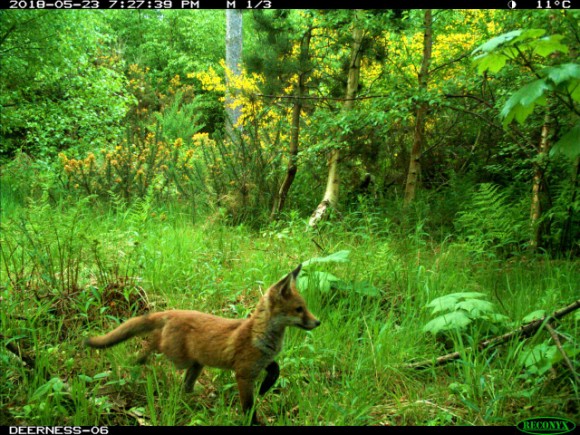
Published on September 11th 2023
MammalWeb Newsletter Autumn 2023
Hello and welcome to the autumn edition of the MammalWeb Newsletter! As summer bids us adieu, we take a moment to reflect on the incredible journey we've embarked on this season. Through the lens of our camera traps, we've had the privilege of witnessing the enchanting lives of UK wildlife up close. From the bustling badger families to soaring birds, the summer of 2023 has truly been a season of awe-inspiring wonders, even if a little wet!
Our camera traps have been silent observers of these precious moments. As light filtered through the trees, fox cubs engaged in playful escapades, showcasing their innate curiosity and boundless energy. The serene scenes of deer browsing in meadows at dawn remind us of the tranquil beauty that exists beyond our busy lives.
But none of this would have been possible without your unwavering support. Your contributions have supported us by setting up camera traps in strategic locations, and classifying images from across the county, revealing hidden corners of the natural world and shedding light on the behaviours that shape our ecosystems. These glimpses into the secret lives of wildlife not only fill us with wonder but also fuel our determination to conserve and protect these delicate habitats for generations to come.
In this newsletter, we take a dive into the autumn wildlife you might see over the coming months, and a look into how the identification of individual muntjac from camera trapped images might be able to help conservation. We also have a wonderful article discussing photographing foxes that we're very excited to share. We'll also take a look at the events coming up in the next few months, and reveal the results of our camera trap quiz!
Connect with us on social media and be part of the community that celebrates the splendour of our wildlife. Your engagement amplifies our message and spreads and appreciation of nature far and wide. We love hearing from you, if you have any comments, queries, insights, or suggestions our for next newsletter, then please contact us at info@PROTECTED

![]()
August 2023
Sequences uploaded | Sequences classified |
5937 | 7438 |
These values include all photos from the general MammalWeb Britain project, and our other public projects.
August 2023 Spotter League
Congratulations to August's top ten spotters! We very much appreciate everyone's hard work.
Position | User |
1 | WelshHillbilly |
2 | Muddyspringer |
3 | Checchi |
4 | MartaPS |
5 | Nuthatch.18 |
6 | SecretPond321 |
7 | RustyKnight07 |
8 | Laura James |
9 | Mike King |
10 | gcsmith |
Autumn Unveiled: Camera Traps Chronicle Seasonal Shifts
As the vibrant hues of summer fade into the warm tones of autumn, the natural world undergoes a metamorphosis. The shifting landscape presents new challenges and opportunities for wildlife.
From foxes foraging for food in preparation for the colder months to squirrels caching away nuts and seed, our camera traps watch, recording these precious moments. The adaptability of technology allows us to maintain an unobtrusive presence in the lives of animals, ensuring that what we observe remains as close to their natural behaviours as possible.
The data collected through camera trapping provides valuable insights into the effects of changing seasons on wildlife behaviour. By monitoring shifts in activity patterns, feeding habits, and social interactions, we can gain a deeper understanding of the challenges these creatures face as the environment transforms around them.
With autumn's arrival also comes a season of spectacle and grandeur, as we prepare for the deer rutting season. This annual display of power, elegance, and survival instinct is a sight to behold, and camera traps can get a unique insight into this event.
Deer rutting season, which typically occurs during the autumn months for fallow, red and sika deer, is a time of intense competition among the deer. Stags engage in roaring battles for dominance, their antlers clashing as they collect harems of hinds or carve out a place within the hierarchy. These displays of strength and resilience are not only visually striking but also offer a window into the intricate social dynamics that govern these majestic creatures.
But it's not just about the spectacle; it's about understanding the significance of these behaviours. By studying interactions and behaviours, we gain insights into the health of populations, the effectiveness of management, and the role that these creatures play in maintaining the delicate balance of our ecosystems.
As we eagerly anticipate the arrival of autumn and the captivating displays that come with it, we invite you to join us. We have seen some fantastic images come through by our brilliant volunteers, and we can’t wait to see what autumn has in store. Why not help us classify these images and be at the forefront of conservation. Your continued support and enthusiasm are instrumental in helping us understand nature.
.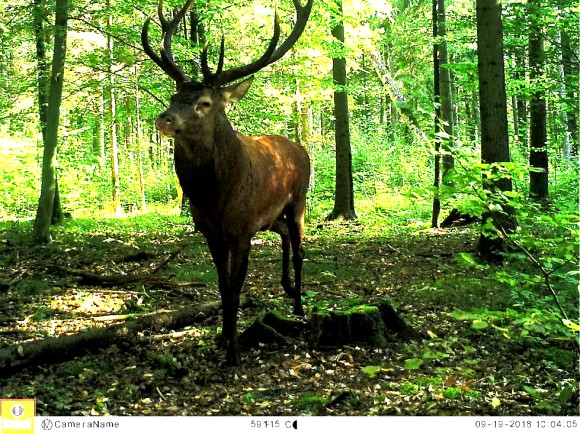
![]()
Muntjac Memoirs: Conservation with Camera Traps
In the intricate tapestry of the UK's wildlife, the muntjac deer emerges as an enigmatic figure. These small deer, often known as the "barking deer" due to their distinct vocalizations, have been the focus of work that highlights the potential of camera traps in conservation efforts. Invasive in the UK, understanding their prevalance is very important.
Muntjac deer exhibit a wide range of individual facial markings, much like the unique fingerprints that distinguish humans. Leveraging the capabilities of our camera traps, we have worked to identify and track these individual muntjacs based on their facial features, as first described by Arnold Cooke in his book titled "Muntjac and Water Deer". This technique may help us gain a deeper understanding of these elusive creatures and, consequently, more effective management strategies.
As our camera traps capture images of muntjac deer throughout their natural habitats, we catalogue and analyse their facial markings. From broken teeth and injuries to signs of age and weight, their unique markings tell a story of each muntjac's life. By identifying individual deer, we can monitor their movements, territories, and behaviours over time, uncovering insights that would have remained hidden otherwise.
This approach holds promise not only in shedding light on muntjac deer behaviours but also in enhancing the precision of management efforts. It may be possible to tailor strategies to the unique needs and habits of individual deer, contributing to the overall health of the ecosystems they inhabit.
Citizen science allows us to share information across the community. We'd love to hear if you have any charismatic individuals that you recognise on your own camaera traps, and how you identify them!
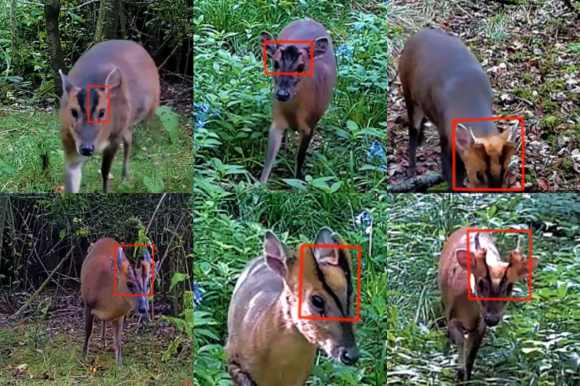
The fox in the foxgloves
Foxes are beautiful and very difficult to photograph – this much I know. I have seen them occasionally in the fields around the town where I live. They move at a gallop, keeping low, moving into undergrowth. These are country foxes, understandably afraid of people. Whenever I have seen a fox, I sit in wait the following day, at the same location, at the same time and in camouflage. The result is always the same: no show. They’re too clever by half and must change their routine daily.
Urban foxes, unlike their country cousins, are often easier to photograph. Imagine my excitement, then, when my sister sent me a photo of a fox in her garden. She asked if I would dog-sit for her Springer spaniel when she went on holiday. That was perfect: 10 days to photograph foxes; what an opportunity. Operation foxglove was launched.
As you’ll appreciate, the golden rule of wildlife photography is not to spook the animals you’ve come to photograph. So, the Springer and my Labrador were kept in at night and I erected my hide on the patio, giving the foxes a few days to get used to the presence of this odd addition to the garden. During this time, I sat in the dark in the comfort of the living room and watched the foxes - a mother and two young cubs - go about their business. The garden was being used as a thoroughfare, as they travelled from their den in an adjacent garden to other gardens in the neighbourhood. After four nights, I moved into the hide and waited for dusk and the arrival of the foxes. One of the cubs would arrive earlier than the others and would occasionally wander through the flower beds at the back of the garden, past the foxgloves. But it was dark, and the photos very grainy. One needs a bit of light to get sharp images. True to form, she (at least I thought of her as a she) was unpredictable and would sometimes not show up or would arrive when it was too dark. Nonetheless, it was still a joy to watch a wild animal go about its normal behaviour. The clock was ticking, and it was suddenly my last night of sitting in my hide before my sister would return from holiday the following day. Would the fox come again tonight? Luck was with me. The little cub slipped into the garden early. She padded along behind the flowers and, next to the foxgloves, paused for a second or two and turned to look at my hide. I held my breath, my heart raced, and Snap! I took the picture. Was it worth all the hours of waiting? You bet. I’m still haunted by the memory of this pretty animal and I wonder where she is now.
Steve Lindsay 07/09/2023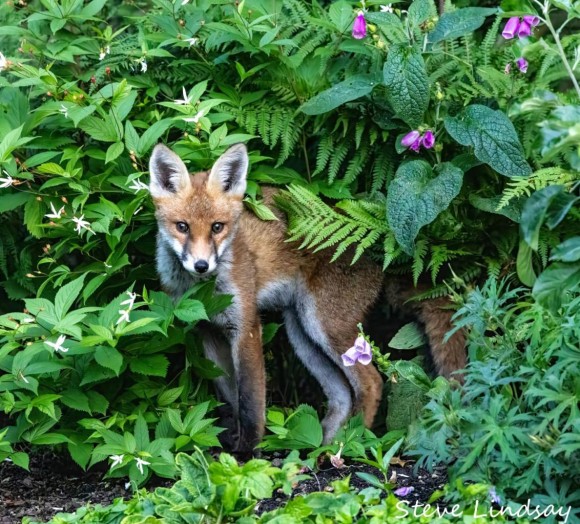
Thank you for reading our Autumn edition of the MammalWeb newsletter. As we conclude this edition, we encourage you to stay engaged, stay curious, and stay connected. We hope these articles have provided you with a deeper insight into what mammalweb is doing to understand the incredible wildlife that graces the United Kingdom. Stay tuned for more updates, discoveries, and stories.
Talks and Events
Below are some forthcoming events and talks. With a mixture of in-person and online events we hope there is something for everyone to enjoy. For even more opportunities, be sure to look at reserves and sites local to you; there are many opportunities for pond dipping, badger watching, beach cleaning and many more throughout the Summer months!
Mammal Fact of the Month
Water voles live in colonies along a watercourse, and can have home ranges up to 300m long! A once common site across the UK, water voles are now scarce due to pollution, urbanisation, predation by American mink and habitat loss.
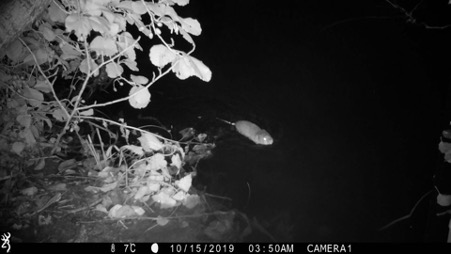
![]()
Camera Trap Quiz
Well done to everyone who managed to identify the Polcecat in last month's camera trap quiz! Living in lowland woodland, marshes and riverbanks, polecat populations dropped significantly in the past and they were almost extinct in the UK. But, due to conservation efforts, they are gradually repopulating rural Wales and England.
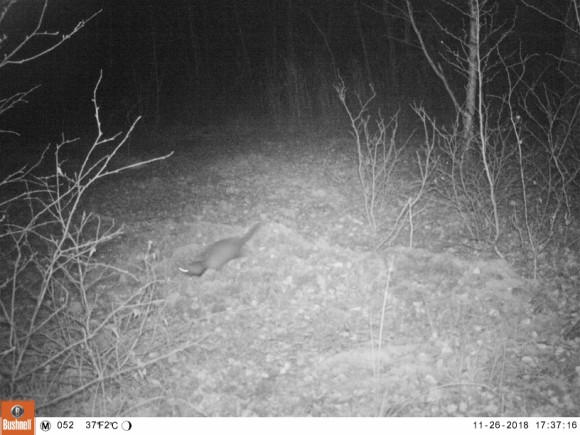
![]()
Below we have this newsletters camera trap quiz. Let us know what you think!
Remember, if you enjoy the camera trap quizzes and want to try some more, we do one weekly on our social media! These are posted across our Twitter, Instagram and Facebook accounts.
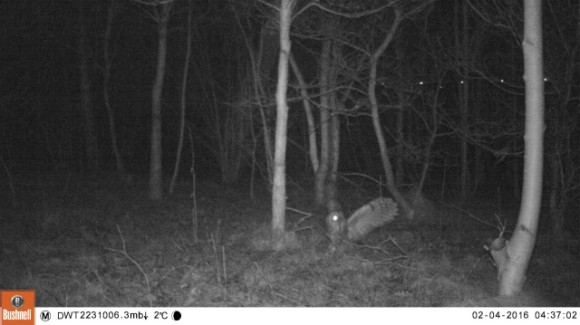
![]()
Published on August 8th 2023
Hello and welcome to the July issue of the MammalWeb Newsletter! We're heading towards the end of the Summer now, but for many of us the warm weather is far from over. The late summer evenings are perfect for doing a bit of wildlife spotting, so head out at dusk and see what you can find!
This month, we have some truly interesting articles: some news on recent publications, tips and information on capturing footage of squirrels, and an outline of some updates to future newsletters. Plus, as always, a list of upcoming talks and events and our monthly Camera Trap Quiz.
We love hearing from you, if you have any comments, queries, insights, or suggestions for next month’s newsletter, then please contact us at info@PROTECTED
| Sequences uploaded | Sequences classified |
|---|---|
| 3922 | 3505 |
These values include all photos from the general MammalWeb Britain project, and our other public projects.
Congratulations to June's top ten spotters! We very much appreciate everyone's hard work.
| Position | User |
|---|---|
| 1 | SecretPond321 |
| 2 | emvcaest |
| 3 | RustyKnight07 |
| 4 | MJupe88 |
| 5 | 1bachA_sanblas |
| 6 | IreallylikeRavens |
| 7 | cam trap |
| 8 | Jimmytheeel |
| 9 | Jo Young |
| 10 | vivcoy |
MAMMALNET - Citizen Science Data Collection from a One Health Perspective
This paper was published in July with the involvement of MammalWeb team members Phil Stephens and Graham Smith. It reports on the way that 3 systems are collaborating so that data can be combined from ad-hoc reporting (via the iMammalia app), citizen science camera trapping (via MammalWeb) and structured camera trap surveys (via the Agouti platform), with a view to improving our knowledge of wild mammal distributions and abundance across Europe. That, in turn, is really important because major processes, such as disease transmission and species invasions, typically don’t respect geographic borders. Consequently, greater international collaboration is essential to documenting and managing problems.
The paper is available to read here through CABI Digital Library.
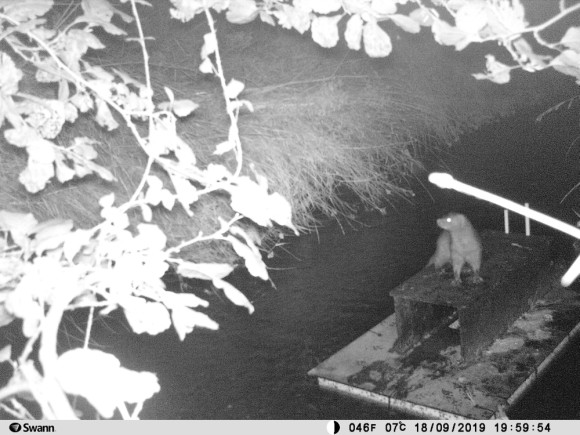
American Mink, Neogale vison. Credit: Hyslop, from MammalWeb’s archives
Feral American Mink Neogale vison continues to expand its European range: time to harmonise population monitoring and coordinate control.
Linking on from the MAMMALNET paper, this paper published in the Mammal Society's Mammal Review back in May (also with the involvement of Phil Stephens and Graham Smith), focuses on one example of a perpetrator of disease transmission: the American Mink. This paper equates to an international collaboration to update understanding of mink distribution and abundance, as well as the efficacy of management policies.
Invasive mink populations across Europe have been increasing over the last 15 years and, in some areas of the continent, there have been issues with consistent control as the fur farming industry can cause problems with listing the animal on government invasive species lists. This, combined with other factors such as lack of data, highlight a widespread need for comprehensive and publicly available data collection. This is being achieved through camera trapping, population censuses and records from hunting bags, among other means. These methods remain fallible, but the combination of a number of different methods over a prolonged time period helps to map distribution and keep up-to-date records for tracking population control, management, and monitoring efforts across Europe.
This paper is available to read here through Wiley Online Library.
Here is a link to footage of an American Mink from our Deerbolt project.
In February of this year, the Eastern Lowlands Red Squirrel Group was established. This group covers Fife, Clackmannanshire and parts of Stirling and Perth & Kinross. Working with local volunteer groups and the organisation Saving Scotland’s Red Squirrels (SSRS), they are aiming to boost practical red squirrel conservation across the Eastern Lowlands area of Scotland.
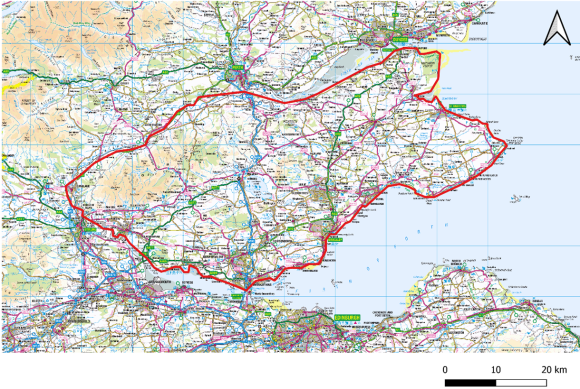
Map of the Eastern Lowlands Red Squirrel Group monitoring area, Scotland.
They are currently running a trap loan scheme, including feeders and camera traps, for participating volunteers. This includes a specific set-up for feeder monitoring, using a combination of camera trapping and sticky traps for collecting fur. These fur samples are then examined using microscopy to differentiate the samples, identifying the presence of both grey and red squirrels, as well as the occasional pine marten. This, as well as camera trapping, enables monitoring species presence and population levels, meaning that effective and sustainable population control measures for grey squirrels can be put in place.
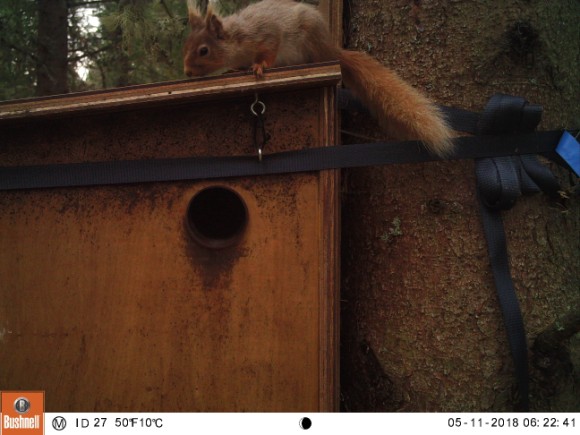
Red Squirrel (Sciurus vulgaris). Credit: LdR, from MamalWeb’s archives.
Camera trapping tips for targeting squirrels:
Unlike some other small mammals, squirrels are not hard to capture with a regular camera trap set-up (as detailed here on our website). If you are looking to target them, specifically, the first thing to do is find the right habitat. For example, grey squirrels are a common sighting across the UK, making their homes anywhere from city centres to secluded woodlands. On the other hand, our native Red Squirrels have more specific needs, and are most commonly found in denser woodlands that are either conifer or mixed conifer/broadleaf. Once you have located an area that you suspect may house either reds, greys, or a mixture of the two, the best thing to do is have a look for some squirrel signs. The most recognisable squirrel sign is the chewed pinecone, typically plentiful in areas with a healthy population of red squirrels. However, there are other signs to watch out for as well. These include hazelnuts with a distinctive eating pattern, ‘dreys’ or nests in trees, and even footprints, if the conditions are right. The organisation Trees for Life have a helpful guide to red squirrel signs, available here.
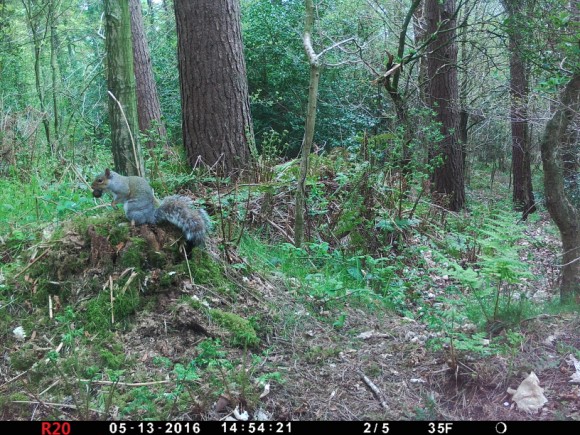
Grey Squirrel (Sciurus carolinensis), captured by a traditional ground-based camera trap set up. Credit: Mammal Monitors, from MammalWeb’s archives.
If you are in an area with grey squirrel presence, the chances are you’ll spot them quite frequently! They have a reputation for making themselves known, especially where bird feeders are concerned - although several products are available to deter them from eating your birdseed.
Different organisations employ different methods for squirrel-focused camera trapping. Saving Scotlands’ Red Squirrels suggest using a small mammal camera trapping box (a Littlewood box for small mammal camera trapping) placed at least 3m up in a tree and baited with squirrel mix. This is a good method for getting close-up footage of the animals, but it can be time-intensive to build and set up and, for monitoring populations, is not strictly necessary. Feeding stations faced with camera traps are a reliable way to monitor squirrels, with many organisations such as the East Lowlands Red Squirrel Group using this setup.
As stated above, squirrels are not particularly hard to capture on a traditional trail cam setup, but using feeding stations in trees may reduce the amount of non-target species captured.
You can help monitor and conserve red squirrels by reporting all of your squirrel sightings, red or grey. Links to squirrel monitoring organisations, across the UK, to which you can report sightings can be found here at the UK Squirrel Accord.
You can enquire about volunteering opportunities with East Lowland Red Squirrel Group here.
MammalWeb have also run squirrel-focused projects in the past, so keep an eye on our project list https://www.mammalweb.org/en/project-list for anything to contribute to!
Firstly, we want to thank all of you for supporting the MammalWeb project by subscribing to our newsletter, we hope you have enjoyed keeping up with project developments! Our team of voluntary staff work very hard on putting the newsletter together each month and we hope you agree they have been doing a fantastic job. However, you may have noticed a few newsletters coming out a little later than expected recently. In order to reduce workload while maintaining the quality of newsletters we are going to trial reducing the frequency of newsletters to quarterly rather than monthly. We feel this will be enough to keep you updated on project progress and developments, but we will also be posting more regular updates on our social media platforms and any major news on our website news page.
We would also like to take this opportunity to invite feedback on our newsletter. For example, which aspects are you most/least interested in? Is there anything that you would like to see more of in our newsletters? Please send any comments or suggestions to us at info@PROTECTED
Talks and Events
Below are some forthcoming events and talks. With a mixture of in-person and online events we hope there is something for everyone to enjoy. For even more opportunities, be sure to look at reserves and sites local to you; there are many opportunities for pond dipping, badger watching, beach cleaning and many more throughout the Summer months!
Surrey Wildlife Trust are running a series of hands-on volunteer days including fence clearance and bracken scything among others! Check out their what’s on page for more information
The South East Pine Marten restoration project is running a day of Equipment Building for Ecological Monitoring for Adults on August 17th
An exciting opportunity to learn more about small mammal conservation at Blashford Lakes Small Mammal Trapping and Handling Workshop on August 22nd
Rewilding Britain have a series of past Webinars available to watch here at any time
The Red Fox is one of the most widespread mammal species in the world, with the largest natural distribution of any mammal (barring humans). They are also a species that is familiar and present whether you live in the heart of a city or in the most remote of rural cottages. Because of this, they aren't just present in the public eye but in our history and literature as well; they have been at the centre of a myriad of mythologies and folkloric tales.
In the UK, a traditional common name for the Fox is 'Reynard'. This came to middle English from the French “Renart”, shortened from 'Roman de Renart', a medieval fable surrounding anthropomorphic animals, and the precursor to Chaucer's The Nun's Priest's Tale. The folkloric Reynard the fox is characterised as a sly, cunning trickster figure.
Over the centuries, the Fox in Britain has gathered a wealth of stories, fables and old wives' tales, but the most enduring surrounds the way that wily Reynard gets rid of fleas. As the story goes, Reynard the fox finds himself with an itchy infestation, so he finds a piece of woollen fleece and takes it between his teeth. Then, he finds a pool of water - a pond, lake or stream - and slowly backs in to it. As his body is submerged, the fleas seek refuge above the water, moving higher and higher as he goes deeper. At last, he is submerged up to his nose and the fleas have all fled onto the piece of fleece that he is diligently holding above the water. At this point, he releases the fleece and it is carried away by the current, taking the fleas with it. Then, he makes his way out of the water and is off - leaving the fleas behind.
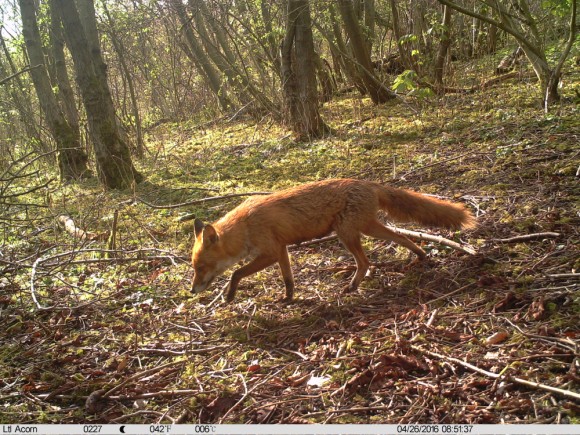
Red Fox (Vulpes vulpes). Credit: vkent, from MammalWeb’s archives.
Well done to everyone who managed to identify the Brown Rat (Rattus norvegicus) in last month's camera trap quiz! This was a tricky one - there was some debate over whether it was a hedgehog or a rat, but the blunt snout, visible ears and sleek looking body all point towards rat. Send us an email at info@PROTECTED to let us know what you think!
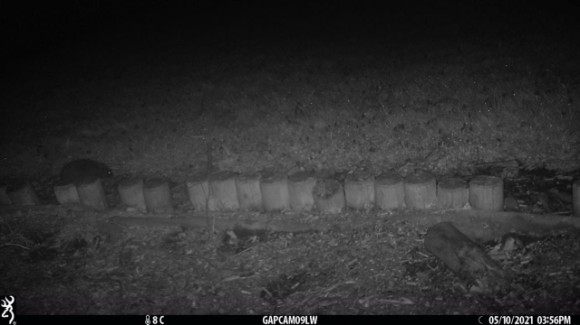
We've got a topical quiz for you this month, have a good look and let us know if you spot the species hiding in the image!
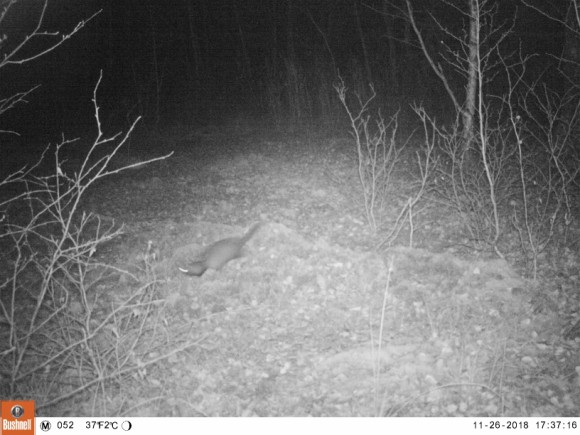
Remember, if you enjoy the camera trap quizzes and want to try some more, we do one weekly on our social media! These are posted across our Twitter, Instagram and Facebook accounts.
Published on July 5th 2023
MammalWeb Newsletter June 2023
Hello, and welcome to the June edition of the MammalWeb newsletter. As spring fades into summer and we look forward to the sunshine ahead, our wildlife is busier than ever making the most of the long evenings and warm weather.
In this edition, we have a range of exciting topics to talk about, from the hidden family lives of fallow and how we can spot them, to celebrating world ocean day, and an exciting development for Scottish wildcats.
So, let’s dive in and discover the wonders of June!
We always love hearing from you. If you have any comments, queries, insights or suggestions for next months newsletter, then please contact us at info@PROTECTED
May 2023
| Sequences Uploaded | Sequences Classified |
| 6049 | 5854 |
These values include all photos from the general MammalWeb Britain project, and our other public projects.
May 2023 Spotter League
Congratulations to May's top ten spotters! We very much appreciate everyone's hard work.
| Position | User |
| 1 | SecretPond321 |
| 2 | gaymansam |
| 3 | Gillingham |
| 4 | emsknock |
| 5 | RustyKnight07 |
| 6 | Jo Young |
| 7 | MadeinWales |
| 8 | romypopham |
| 9 | Daisy.mead841 |
| 10 | craigdenniswildlife |
Saving Wildcats Update
Many of you will be familiar with MammalWeb's continued involvement with the Saving wildcats project, which aims to conserve and protect this iconic species within the Scottish landscape.
In a fantastic move forward for the conservation of the Scottish Wildcat, the saving wildcats project released 22 wildcats into the Cairngorms National Park in June, with the hope of ensuring the survival of this critically endangered species.
The individuals were born in a conservation breeding centre in 2022, and there are plans for similar releases to occur in 2024 and 2025. As with any conservation project, we can’t fully know the outcomes, and careful research and monitoring will be conducted from this first release to help inform future conservation work.
The release of 22 wildcats back into the Scottish wilderness is a milestone achievement in the ongoing campaign to preserve them. It symbolizes a collective commitment to the conservation of Scotland's unique wildlife heritage as the wildcats reclaim their rightful place in the Scottish landscape.
This endeavour offers hope not only for the Scottish wildcats but for the broader global effort to conserve endangered species and protect the delicate balance of our planet's ecosystems.
To find out more, and discover how you can help this endangered species, please visit the saving wildcats website: https://savingwildcats.org.uk/
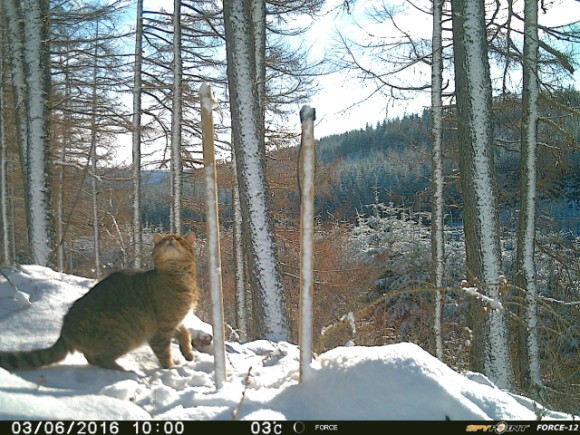
Camera Trapping for Deer
May and June sees the arrival of fawns in woodlands across the UK, with Fallow, Roe, Red, Sika and Chinese water deer all giving birth around this time. Muntjac, conversely, breed throughout the year! In late spring, you may be lucky enough to see mothers moving their fawns through the grass, but in reality, most fawns spend their first few weeks of life stashed away in tall foliage while their mothers’ feed.
Camera traps are a great way to spot these elusive youngsters and their families, and we’ll be exploring some of the best ways to photograph and observe deer in their natural habitat using them. We’ll be focusing on mainly Fallow deer in lowland England, although extensive work has been done on red deer in Scotland and Muntjac and Chinese water deer in the east midlands.
Before setting up a camera trap for any species, it’s good to understand a bit about their habits and behaviours throughout the year. Fallow are one of our most commonly found deer species in the UK. Introduced by the Normans around the 11th century, they were used mainly as an ornamental species in deer parks, before escaping and being released into hunting forests. They can now be found abundantly and are considered as ‘naturalised’ in the UK.
To spot them, you’ll have to place a camera trap where they already are. Woodland is a good place to start, and signs may include browse lines where they have nibbled leaves, dung, or the tracks (or slots) they form in the ground. Well used paths weave through the undergrowth, and may also be used by badgers, foxes, muntjac, hare and more!
Once you have found an area, and secured landowner permission, secure your camera trap to a tree or post about 75cm to 1m off of the ground. As with our article on camera trapping to observe squirrels last month, sometimes it’s useful to place sticks in between the camera trap and the tree to get a better angle if the tree is at a slope. Remember, deer are crepuscular animals, so are often more active at dawn and dusk, and move throughout the night, so it may be worth ensuring you have night vision enabled.
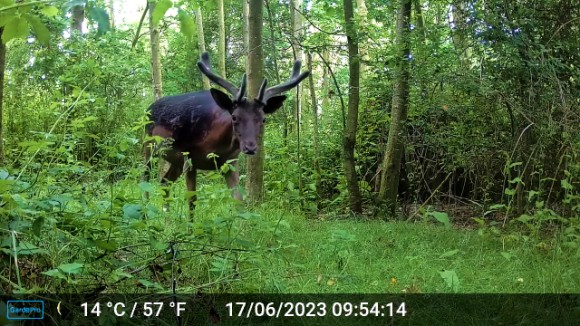
Once your camera trap is positioned, it’s time to wait! It’s best to leave your camera trap for as long as possible, at least a few weeks. Deer are highly cautious animals, especially at this time of the year, with a highly developed sense of smell. We don’t want to be scaring them away before we’ve seen them!
Once you’ve started seeing deer, it may even be possible to identify individuals, which we’ll cover in a future edition, so stay tuned!
Celebrating World Ocean Day
On th 8th of June we celebrated world ocean day. Covering 2/3 of our earth's surface, many mammals of the British isles call the sea their home, including seals and over 20 different species of whales and dolphin. With breathtaking coral reefs, vast marine ecosystems, and mesmerizing marine creatures, they are truly a marvel to behold.
However, human activities such as overfishing, pollution, and climate change pose significant threats to their delicate balance. World Ocean Day reminds us to appreciate the beauty and resilience of our oceans and to work towards safeguarding their health for future generations.
Efforts to protect marine habitats, reduce plastic pollution, and mitigate climate change are vital in preserving the integrity of our oceans. Organizations, governments, and individuals around the world are coming together to implement sustainable practices, create marine protected areas, and promote responsible fishing practices. Whether it is participating in beach clean-ups, reducing single-use plastics, or advocating for policy changes, every action counts.
By educating ourselves and spreading awareness, we can inspire others to join the movement and collectively create a ripple effect of change. Together, we can ensure that future generations inherit a world with thriving oceans, abundant marine life, and a sustainable blue economy.
You can learn more about our fantastic oceans, and what you can do to help protect them, by visiting https://www.projectseagrass.org/

Talks and Events
Summer is a busy time for all of us, and we’ve got lots of talks and events to be on the look out for this month.
Mammal Fact of the Month
Right or left-handed?
Chinese water deer lack antlers, and use their impressive tusks to fight instead. According to research performed by Arnold Cooke on Chinese Water Deer at Woodwalton Fen, Chinese water deer may have handedness during fights! Photos and videos taken seem to show deer circling one another in an anti-clockwise direction, while left ears tend to be damaged more than right ears, indicating that injuries may have resulted from fighting behaviour as opposed to accidental injury from thorns or barbed wire.

Camera Trap Quiz
Well done to everyone with a keen eye last month who spotted the buzzard hidden amongst the leaves! These raptors are impressive predators and can be seen widely across the UK, breeding in England, Wales and Scotland.
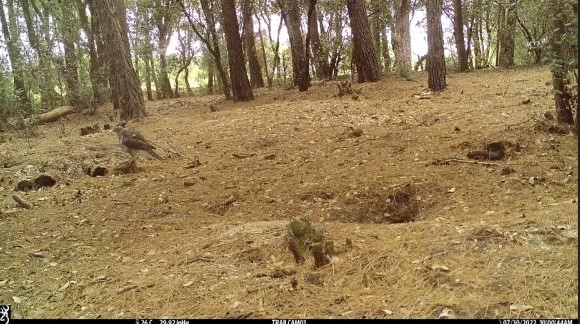
For this month's camera trap quiz, please let us know what you think this critter may be!
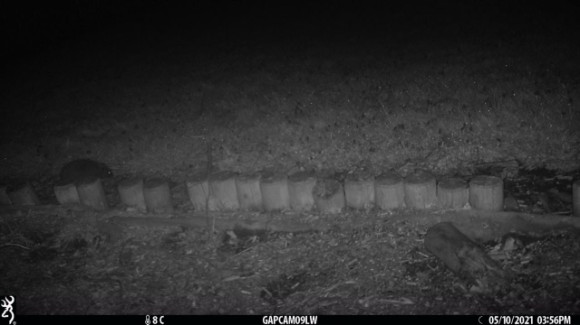
Remember, if you enjoy our camera trap quizzes and want to try some more, we do one weekly on our social media! These are posted across our twitter, instagram and facebook accounts.
Published on June 5th 2023
Hello and welcome to the May issue of the MammalWeb newsletter!
Summer is well and truly upon us, and we're entering into a very exciting season for monitoring and conservation. Swallows, swifts and housemartins are back from migration and making their nests, and the long days and warm nights are perfect for getting out and watching for mammal activity. This month we've got some exciting updates for you: some information on our work with ConservationAI, a World Otter Day special, some top tips for catching squirrel footage, an update on the Saving Wildcats project, and a lovely introduction to our new intern Eloise!
We love hearing from you, if you have any comments, queries, insights, or suggestions for next month’s newsletter, then please contact us at info@PROTECTED
| Sequences uploaded | Sequences classified |
|---|---|
| 9654 | 6805 |
These values include all photos from the general MammalWeb Britain project, and our other public projects.
Congratulations to April's top ten spotters! We very much appreciate everyone's hard work.
| Position | User |
|---|---|
| 1 | WelshHillbilly |
| 2 | SecretPond321 |
| 3 | craigdenniswildlife |
| 4 | Otter_Spotter |
| 5 | PetaSams |
| 6 | Jo Young |
| 7 | RustyKnight07 |
| 8 | MadeinWales |
| 9 | 1bachA_sanblas |
| 10 | Spugwash |
We’re excited to announce that we have recently been awarded funding to work with ConservationAI, based at Liverpool John Moores University, to integrate AI image recognition into MammalWeb. ConservationAI have been using AI to detect and classify animals from camera trap images from around the world, including typical UK fauna. Although the models will need to be trained to recognise more classes of birds and mammals, the current system shows huge promise. Indeed, in a trial last year, Shengyao Ni (a Master of Data Science student at Durham University) showed that classifications submitted by MammalWeb spotters already agreed with ConservationAI’s classification in 73% of cases. Where classifications from the two sources did agree, they were correct in 99.8% of cases. As ConservationAI’s model is extended to include the rarer species, the 73% is expected to increase rapidly. Whilst we don’t expect AI to replace the efforts of our participants, it should make the process of reaching consensus much quicker, so that the data can be put to use much more rapidly. It will also ensure that Trappers get rapid feedback on what they’ve uploaded. Training and enhancing AI models is also an iterative process, with which Spotters can provide enormous help. We’re looking forward to working with Carl and Paul over coming months, and will bring progress updates as the partnership develops.
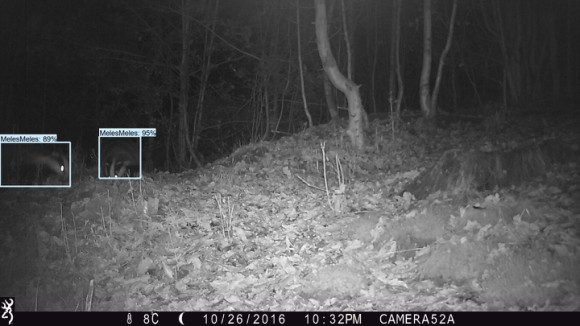
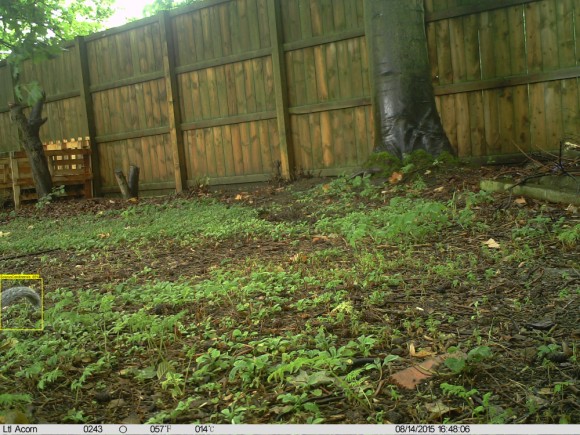
ConservationAI’s models are very robust for camera trap pictures of our more recognisable species (top; Meles meles is the scientific name of the badger). However, we’re also impressed by how well they can recognise even partial photos of smaller species (bottom; Sciurus carolinensis is the scientific name of the grey squirrel)!
The 31st of May was World Otter Day, and we’ll happily take any opportunity to talk about these fantastic mammals! Here in the British Isles we have one species of otter, the Eurasian Otter (Lutra lutra) which can be found in both freshwater and coastal environments throughout these countries. In fact, there are some subpopulations that are so well adapted to living on these coasts that signs of them evolving into a separate subspecies have been recorded! One example of this is the population found on Shetland, which you can read about in the book ‘Otters in Shetland - the tale of the draatsi’ by Richard Shucksmith and Brydon Thomason.
Otter populations across the British isles have shown a remarkable recovery in recent years, however our lack of riparian woodlands, increased pollution, and the introduction of invasive species such as American mink, combined with the canalisation of rivers across the UK, is damaging this vital habitat. This not only effects charismatic mammals such as otters and water voles, but has a knock-on effect throughout all of our freshwater environments.
You can help protect and revive freshwater ecosystems by raising awareness of these issues, volunteering with local wildlife agencies if you are able, and - crucially - monitoring populations and species by continuing to put out your camera traps to record these enigmatic animals.
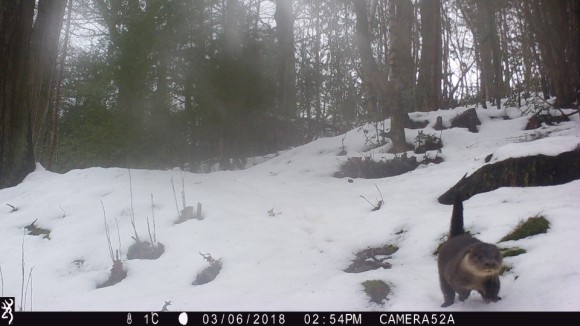
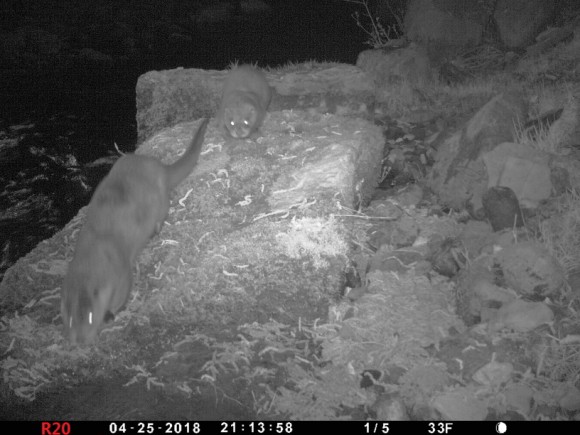
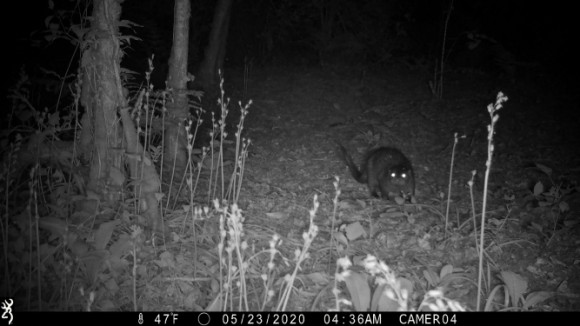
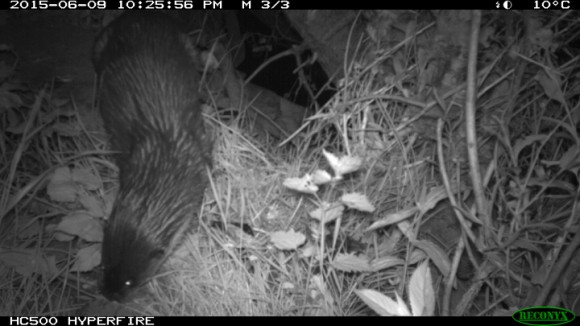
To continue to celebrate Otters this month we’ve compiled a small selection of footage from our contributors, posted above, and we would love for you to share any otter footage you’re particularly proud of by sending it to us at info@PROTECTED!
Whether you live in the heart of a city or in a tiny village, the chances are you’ve seen a squirrel up-close and personal. The chances are, again, that for a lot of you it was a Grey Squirrel, the non-native species introduced from North America around 200 years ago.
Though non-native, the grey squirrel is now the most common squirrel species in the British Isles, with an estimated 2.7 million grey squirrels compared with 287,000 of our native reds.
With all of these squirrels running about, you may be wondering what’s the best way to get some footage of them on your camera traps. Fortunately, we’ve got some top tips and guidance for you.
Firstly, camera trapping can be an excellent tool for population monitoring and if you are fortunate enough to get footage of one - red or grey! - you should consider reporting it to your local squirrel group or branch of the Wildlife Trusts.
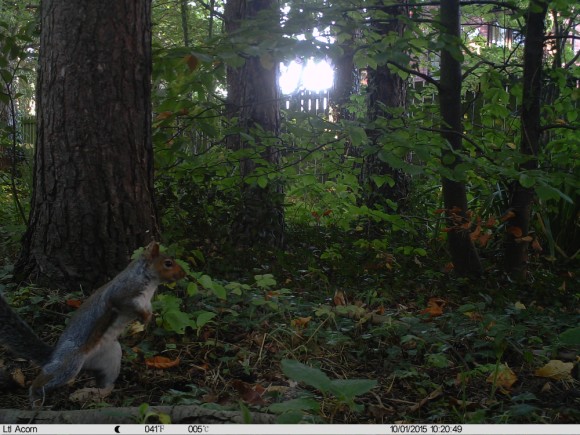
Footage of a grey squirrel on woodland floor.
There are a couple of tried and tested methods for specialising in squirrel shots when setting up your camera traps. The first is to set up a specialised feeding station. Those of you with bird feeders in areas with grey squirrels are probably very aware of the attraction bird seed (particularly raw peanuts!) holds to these small mammals, so it’s no surprise that specialised feeding stations exist.
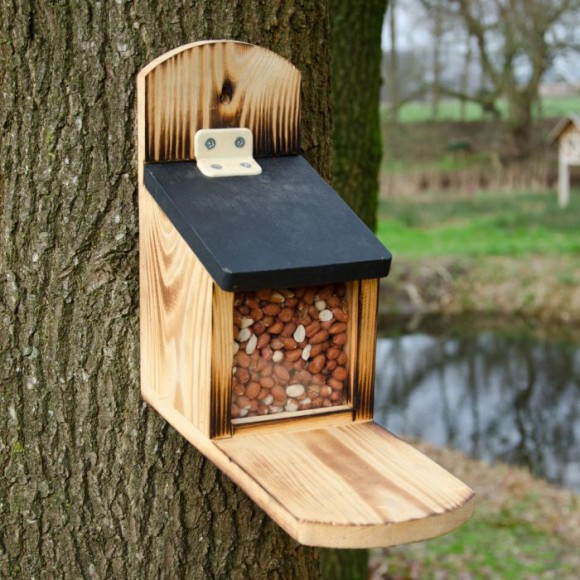
Image of a squirrel feeder taken from CJ Wildlife here.
The first step in any camera trap placement that aims to target a specific species or type of animal is to look for areas that would be prime habitat or areas that you know they are present. In the case of squirrels, particularly reds, there are useful maps available through the wildlife trusts and red squirrel survival trust.
Another way to go about this is to look for sign, red squirrels are often prevalent in conifer woodlands and have a distinctive way of eating pinecones (pictured below) that gives a good indicator of their presence.
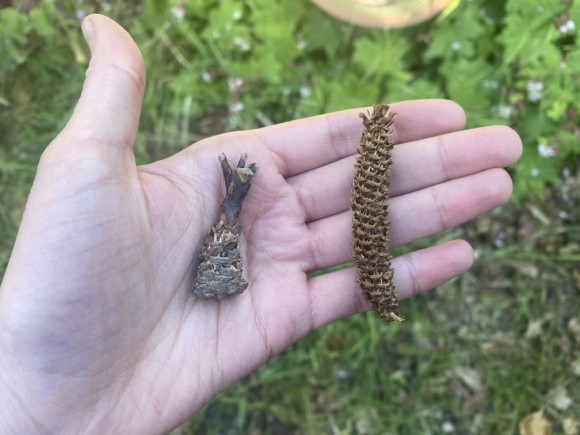
Image of two different conifer cones eaten by red squirrels.
Once you have found a suitable area and ensured you have landowner permission if necessary, place your feeder above ground (1 to 3 metres) against a tree or wall so that the squirrels can access it without having to move across the ground, and set up your camera facing it. An additional option for species monitoring within your feeder is to place a ‘sticky trap’ on the inside of the lid which is designed to collect fur from any visitors. Analysing this fur when checking the feeder can give a good indicator of the primary species being attracted and works alongside any camera trap footage as a failsafe population indicator.
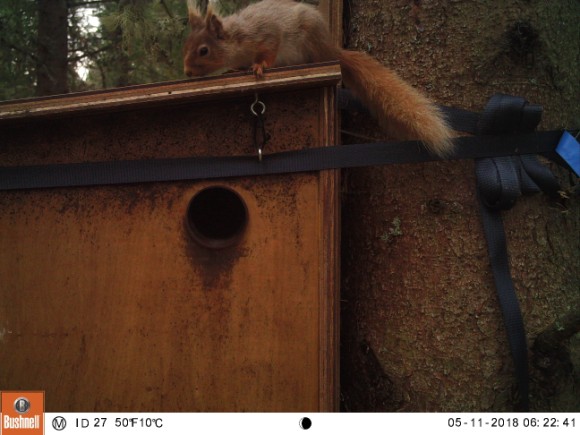
Footage of a red squirrel on top of a bird nesting box.
In areas such as some in Scotland and Wales red squirrel habitat overlaps with that of pine Martens, and in such places its not uncommon for Martens to also visit squirrel feeders. In fact, areas that these two native animals intersect have provided evidence that the Martens provide significant benefits to the red squirrels through controlling populations of greys.
The other option is simple: ground-based camera trapping, the way you would for most species. This has been used in studies on population density for grey squirrels, including one by our very own Sammy, and is proven as a suitable way to capture squirrel footage.
The first step of choosing the correct location for your camera still remains the same, and there is still the option of using bait (the methodology of which is described in this paper A camera trap method for estimating target densities of grey squirrels to 2 inform wildlife management applications). It is recommended that you set any camera trap intended to capture smaller mammals angled slightly downwards to ensure the correct line of sight. This can be done very simply by wedging a stick, stone or other debris (personally I’ve used a myriad of half-chewed pinecones in the past), as is outlined in our Mammalweb Trappers guide.
We look forward to seeing all of your squirrel footage! Monitoring these populations is massively important for the conservation of our native reds and camera trapping is a fantastic and effective way to do so, so please upload and report those sightings!
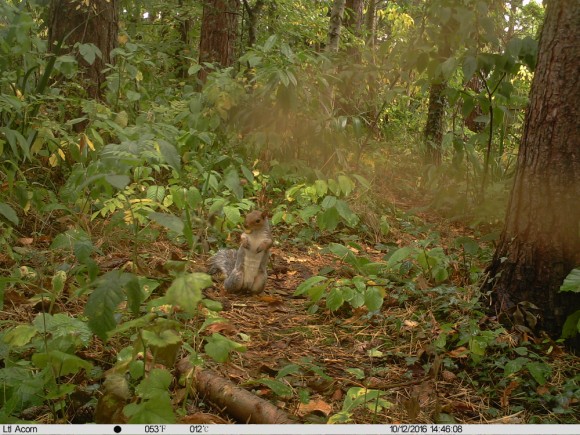
Footage of a grey squirrel taken from a ground camera.
We’re entering into June now and the Saving Wildcats project is reaching an all important milestone - the first release of captive-bred cats into the wild! For those of us who have been following the project, the progression of these wildcats through their birth in the breeding-for-release centre at RZSS’ Highland Wildlife Park last year to their imminent release has been a journey of nervous excitement.
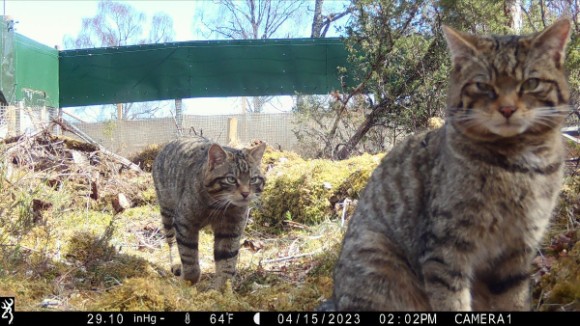
Camera trap footage of wildcats inside the pre-release enclosure at Highland Wildlife Park.
The scottish population of the Eurasian Wildcat (Felis sylvestris) has been at risk of extinction for decades. These cats were once widespread throughout the British Isles but can now only be found in remote areas of the Scottish Highlands, with their population deemed inviable. The Saving Wildcats project has been working on a breeding for release programme for the past decade, with it coming into fruition at the start of last year. The programme is modelled after a success story with the Iberian Lynx in Portugal, and adapted for our smaller native wildcat.
The project also holds incredibly exciting implications for the rest of the UK with teams in England and Wales ready to build on it if and when it is deemed a success.
The first release of kittens bred at highland wildlife park from captive cats is due to happen this coming month. The area of land designated is a 600 square kilometre area inside the Cairngorms National Park, on land owned by Cairngorms Connect. Saving Wildcats have volunteers working on reviewing camera trap data of the area, ready to track individuals and monitor threats and behaviour as the project gears up for this all important release.
SavingWildcats have their own newsletter, which you can sign up for here if you wish to get monthly updates on the project, and all news and events can be found on their website.
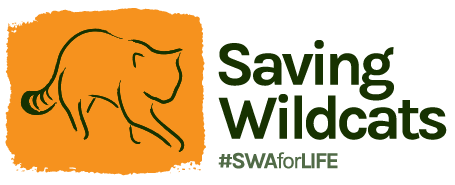
We're all very excited to be working with our new intern Eloise! She'll be helping with our monthly newsletters as well as social media and emails, so keep a look out for her contributions.
"I transitioned towards ecology/hydrology for my masters degree. During my studies, I quickly became interested in geography, and was able to study the influence of red deer on reedbed hydrology for my dissertation. While camera traps weren't used in this research, we instead used drone footage to infer population using track density, it became quickly apparent how useful they might be to study population within the reserve. After graduating and moving last year, I now have two camera traps installed in two different woodlands, and it's always brilliant checking up and seeing what they've seen! I'm eagerly awaiting the arrival of fawns soon.
Communicating data and science is so important, and citizen science plays such a huge role in our understanding of the natural world, so I'm very excited to be joining the team!"

Talks and Events
We've got an exciting selection of upcoming talks and events, both online and in-person, that we've looked out this month. It's also prime season for bat watching, so check up on your local nature reserves to see if they're running any bat walks you can take part in!
Otters world-wide are known to engage in a bizarre behaviour known amongst researchers as a ‘poop dance’, and our native otters are no exception. This ‘dance’ happens after the otters have defecated, and involves them wiggling their bums and tails around in the fresh spraint. This is believed to intensify the smell of the spraint and help this scent to spread further, enticing other otters to investigate and ‘get the message’
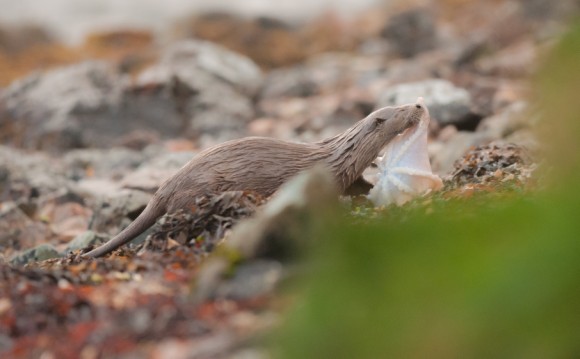
Image of a Shetland otter, taken by otter specialist and IOSF member Alana Dewar.
Well done to everyone who spotted the Brown Rat (Rattus norvegicus) in last month's camera trap quiz! The humble rat is widespread across the British Isles and adept at surviving and thriving in even the most urban environments. In fact, they are one of the most prevalent mammal species in cities throughout the country.
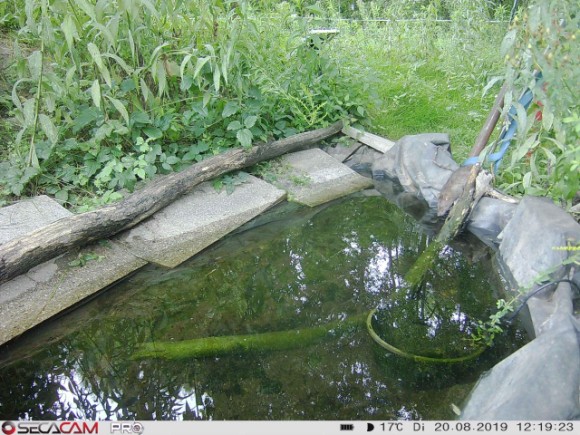
For this month's camera trap quiz, let us know what species you can see hiding in plain sight!
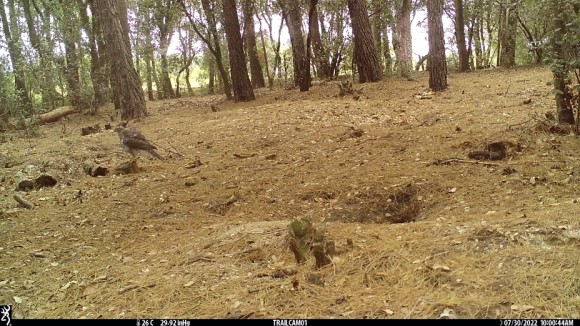
Remember, if you enjoy the camera trap quizzes and want to try some more, we do one weekly on our social media! These are posted across our Twitter, Instagram and Facebook accounts.
Published on May 1st 2023
Hello and welcome to the (slightly delayed!) April edition of the MammalWeb newsletter! In this issue, we will be sharing some information about an exciting partnership between MammalWeb and BTO’s Garden Bird Watch and a vital pilot scheme for a national hedgehog monitoring programme. In addition, we are discussing rewilding, saying goodbye to one of our interns and advertising for a new social media and communications intern. Lastly, as always, we have some exciting upcoming talks and events, a Monthly Mammal Fact, and our monthly Camera Trap Quiz!
We love hearing from you – so, if you have any comments, queries, insights, or suggestions for next month’s newsletter, then please contact us at info@PROTECTED
| Number uploaded | Number classified |
|---|---|
| 9462 | 6724 |
These values include all photos from the general MammalWeb Britain project, and our other public projects.
Congratulations to March's top ten spotters! We very much appreciate everyone's hard work.
| Position | User |
|---|---|
| 1 | SecretPond321 |
| 2 | hillock4 |
| 3 | Moose |
| 4 | PetaSams |
| 5 | JoYoung |
| 7 | VMO |
| 8 | Jimmytheeel |
| 9 | Jotorre |
| 10 | Gingerfox1971 |
Collaboration with BTO Garden Bird Watch
MammalWeb has embarked on an exciting collaboration with the British Trust for Ornithology’s Garden Bird Watch (GBW) project. GBW is a scheme in which thousands of people across the UK participate, recording the species that visit their gardens each week. Some GBW participants already use camera traps, and the BTO are encouraging them to contribute the resultant data to their project on MammalWeb. By combining information from camera traps in gardens with the long-running datasets collected by GBW participants, we hope to learn more about the ways in which mammals and birds interact with each other, and how they interact with the human environment.
The GBW project has illustrated a significant impact of garden feeding on bird communities and populations. We hope to be able to use this partnership to learn more about how garden feeding impacts garden-based mammal populations. In addition, we hope to understand how the management of gardens and the presence of domestic animals affects wildlife, and to determine whether areas that have high bird species richness also have high mammal species richness. To find out more about and get involved in BTO’s Garden Birdwatch Project, follow this link. We welcome new participants who intend to contribute to the two projects.
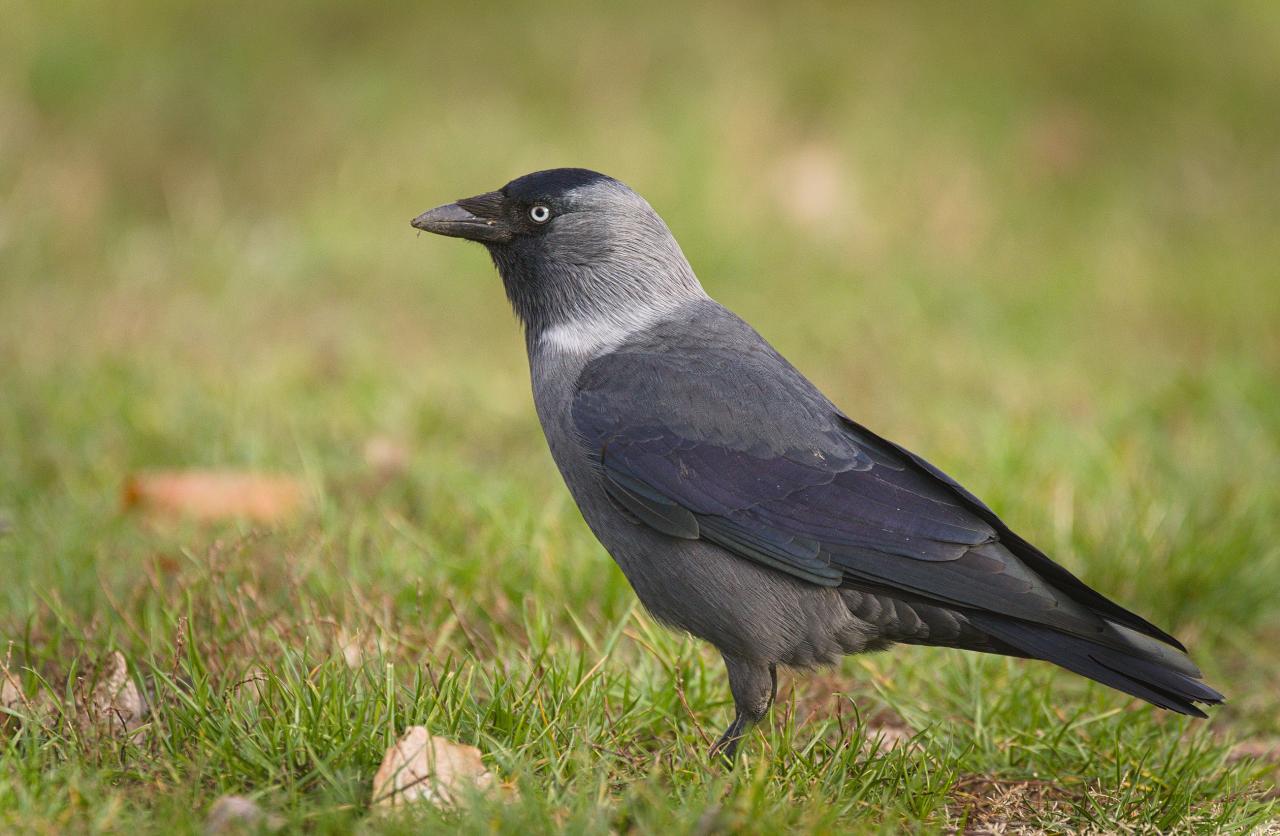
Eurasion jackdaw photo - (C) hedera.baltica (shared under a CC BY-NC-ND 2.0 license)
Pilot National Hedgehog Monitoring Programme
The People’s Trust for Endangered Species (PTES) are almost ready to launch a pilot National Hedgehog Monitoring Programme. The long-term aims of the project team are to engage volunteer partner groups in all regions of the UK, surveying sites that cover all key land classes, and collecting data on hedgehogs and other mammal species in order to produce robust annual trends. PTES envisage that within each region, data on hedgehog populations will be collected from urban and suburban areas, farmland and, ultimately, less well surveyed areas including woodlands and uplands. The data will enable them, with their partners, to understand where hedgehog populations need help, so that targeted conservation action can be undertaken.
PTES and the British Hedgehog Preservation Society (BHPS) have partnered with Nottingham Trent University (NTU), the Institute of Zoology (IoZ) and MammalWeb. The three-year pilot aims to determine how best to collect data on hedgehog populations across the country, in different habitats, and using arrays of camera traps. The data will be analysed using the Random Encounter Model, and approach that enables camera trap data on unmarked individuals to be used to estimate population densities. Using this method will enable robust data to be gathered and population trends to be determined annually. The methods used will also collect data on a range of mammal and other animal species.
PTES are seeking enthusiastic, dedicated regional volunteer groups to partner with. They are inviting Wildlife Trusts, other eNGOs (environmental non-governmental organisations), local mammal groups and universities to a webinar in May to learn more about the pilot scheme and how to get involved. As they join the scheme, each group will be asked to commit to monitoring 2-5 sites per year and make a modest commitment of staff time to coordinate the surveys.
Two dedicated staff members, based at PTES and NTU, will be available to train volunteers in camera trap deployment, data retrieval and storage protocols. Training on species identification will also be provided to enable volunteer partner staff to contribute to data processing on MammalWeb, prior to analysis. The PTES are hoping that interested parties will sign up to a webinar at this link: https://shop.ptes.org/product/ticket/piloting-a-new-national-hedgehog-monitoring-programme-wednesday-24th-may-2023/
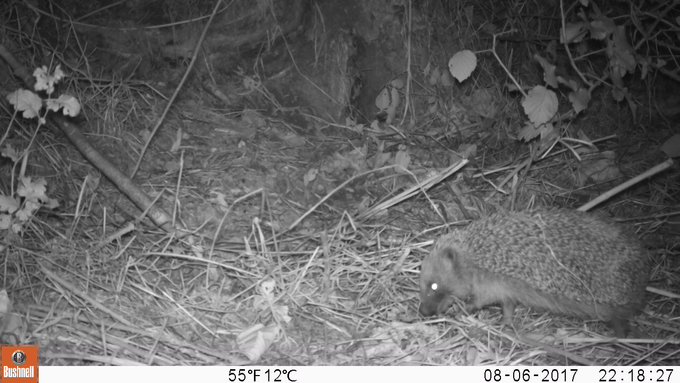
Rewilding
Rewilding is a progressive form of ecological restoration that it is all about letting nature take care of itself – restoring habitats and natural processes, and reintroducing missing species, where appropriate. In recent years, interest in and support for rewilding has grown massively across sectors and age groups, despite the controversy that sometimes accompanies it. According to a poll by Rewilding Britain, 81% of Britons support rewilding in Britain. Rewilding really captures the public’s imagination, creating an inspiring and positive narrative for nature restoration. Being able to see our degraded landscapes bounce back instils hope that we can tackle the climate crisis together. Rewilding Britain have put together a very interesting video showing us what rewilding might look like in the UK's uplands, which you can watch here.
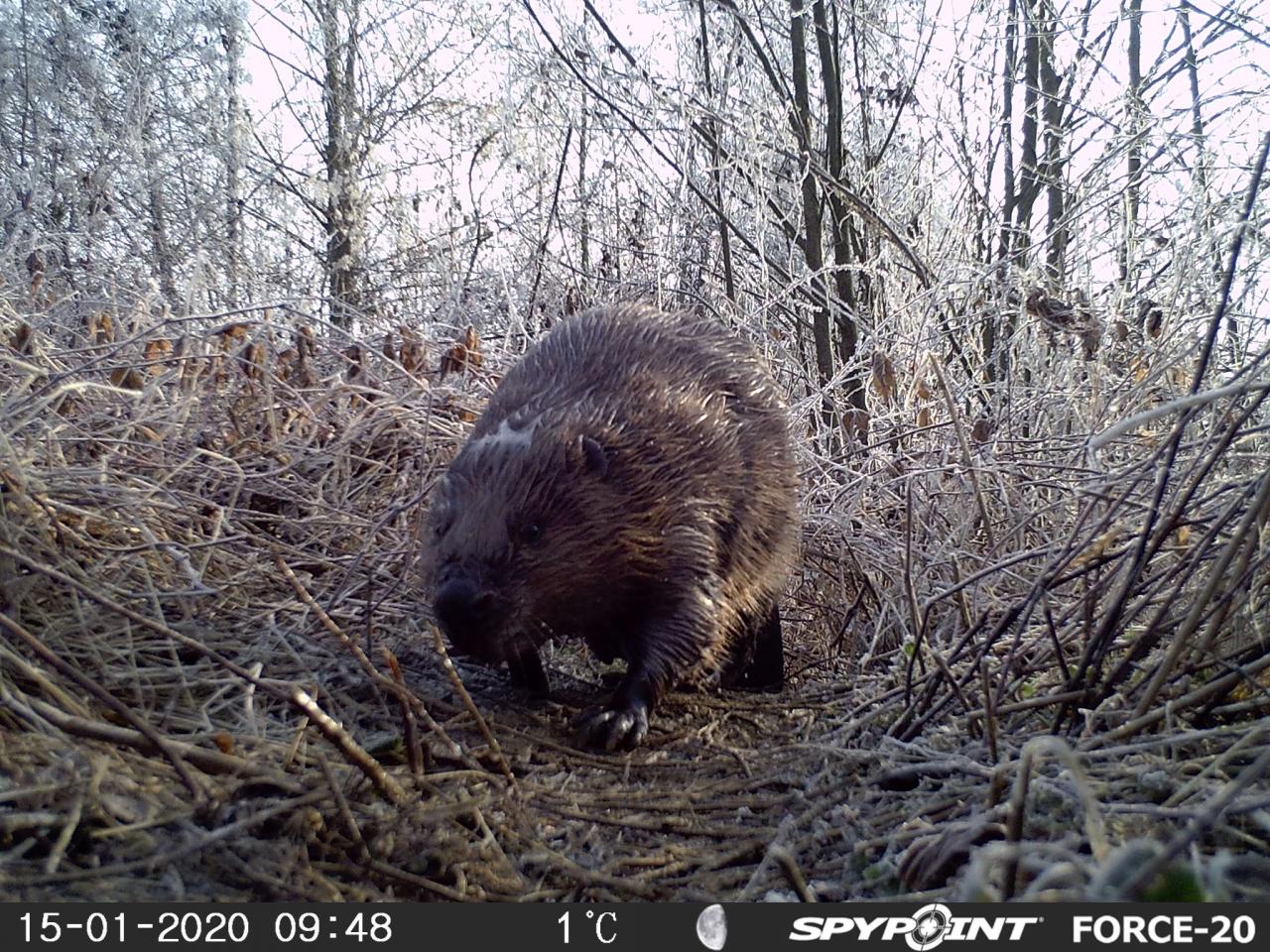
Goodbye to our Intern Lucy
One of our Social Media and Communications Interns, Lucy, is leaving the MammalWeb to start a new communications position at a sustainable fisheries charity. Lucy reports that she has learnt a lot from her work with MammalWeb, having particularly enjoyed creating content for the social media accounts and researching and writing newsletters to share with our wonderful participants. She is very excited to be able to apply the skills that she has learnt at MammalWeb in her new communications position; and is even more excited to be starting a PhD at the University of Sussex in October, looking at floral nectar characteristics .
We’re enormously grateful to Lucy for all she’s done for MammalWeb and we wish her all the best in her next communications role and in her doctoral studies!
Volunteer with MammalWeb
MammalWeb are looking for an enthusiastic volunteer social media and communications intern to join our team! The role will involve creating interesting and engaging social media content and supporting regular communications with all MammalWeb participants. We anticipate this role taking, on average, a couple of hours per week. Work is flexible and can be done at times that suit the candidate. If you’re interested in being more involved the MammalWeb project and looking to increase your communication and social media skills then do take a look at our website www.mammalweb.org and get in touch with the us (at info@PROTECTED) if you have any questions!
Desirable skills/knowledge:
Example tasks:
If you would like to apply, please send a CV and a short (max. one page) cover letter on why you would like to be the MammalWeb intern and your suitability for the role to info@PROTECTED.
Talks and Events
Below are some upcoming talks and events to take part in around the UK. If you’re eager to find out more about wildlife events in your local area, there are plenty of opportunities for outdoor learning and activities advertised on the Wildlife Trusts events page.
Monthly Mammal Fact
Many shrew species, including the common shrew, are able to shrink their own brain! Being the smallest terrestrial mammal, shrews must eat eight or more times their body weight every day in order to have enough energy to survive; this means that they cannot hibernate. Instead, in winter, shrews lose around 28% of the volume of their brain, which is thought to allow them to conserve energy. Astoundingly, shrews are able to regrow much of the lost brain matter again in the Spring. This process of seasonally shrinking and expanding the brain and other organs is called Dehnel’s phenomenon, allowing animals to decrease calorie-consuming tissue when temperatures are low. Little is currently known about the pathways governing this process, and this is attracting much interest from researchers. Understanding the proteins or other triggers responsible for this ability to grow back brain tissue could be very useful in treating neurodegenerative diseases such as Alzheimer’s and multiple sclerosis in humans.
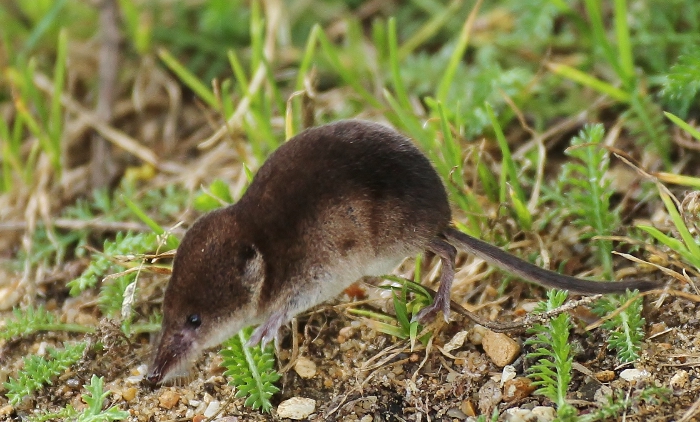
Common shrew photo - (C) Tony Sutton (shared under a CC BY-NC-ND 2.0 license)
Camera Trap Quiz
Well done to anyone who correctly identified the roe deer in last month’s camera trap quiz! The roe deer can be identified by its distinctive white rump and lack of a distinguishable tail. Interestingly, the roe is one of the truly native deer species of the British Isles, with records of roe deer presence dating back to before the Mesolithic period (6,000-10,000 years BC).
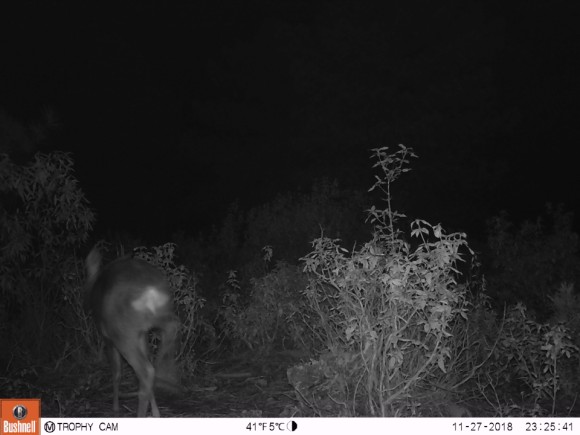
Can you identify the species present in this month’s camera trap photo? Let us know if you can, and we will reveal the answer in next month’s newsletter!
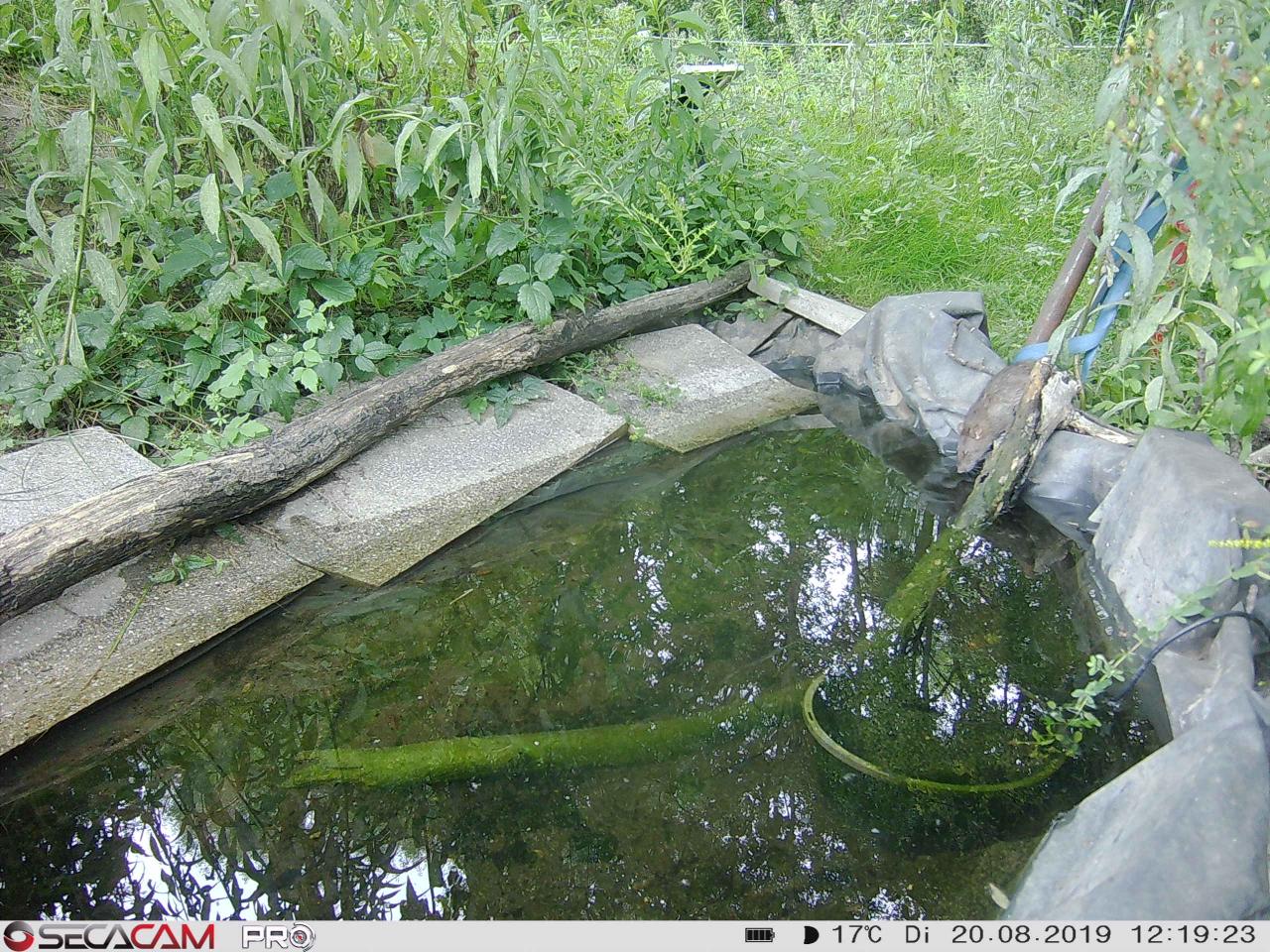
Remember, if you enjoy the camera trap quizzes and want to try some more, we do one weekly on our social media! These are posted across our Twitter, Instagram and Facebook accounts.
Published on March 31st 2023
Hello and welcome to the March issue of the MammalWeb newsletter! Spring is finally springing across much of the British Isles, and with it the species you can spot are changing. Many of our mammal species are coming out of torpor (or hibernation for hedgehogs, dormice and bats), and some wonderful wildflowers are brightening up the green spaces.
In this issue, we’ll be talking about some things to watch out for in the coming months, as well as going through some exciting things the team have been up to. Plus, as always, a list of upcoming talks and events and our monthly Camera Trap Quiz.
We love hearing from you; if you have any comments, queries, insights, or suggestions for next month’s newsletter, then please contact us at info@PROTECTED
| Sequences uploaded | Sequences classified |
|---|---|
| 4819 | 6154 |
These values include all photos from the general MammalWeb Britain project, and our other public projects.
Congratulations to February's top ten spotters! We very much appreciate everyone's hard work.
| Position | User |
|---|---|
| 1 | Deacon |
| 2 | PetaSams |
| 3 | AdamFSmith |
| 4 | ETugwell |
| 5 | Jimmytheeel |
| 6 | Checchi |
| 7 | CharlotteWood |
| 8 | gcsmith |
| 9 | Jo Young |
| 10 | Bagaleu_pallars |
Sammy, Phil and Russ recently attended the celebration event for the wrap-up of the Connecting Schools to Nature project. This project, run by the British Ecological Society (BES) with support from partners including Mammalweb, has helped over 5,000 schoolchildren connect with nature!
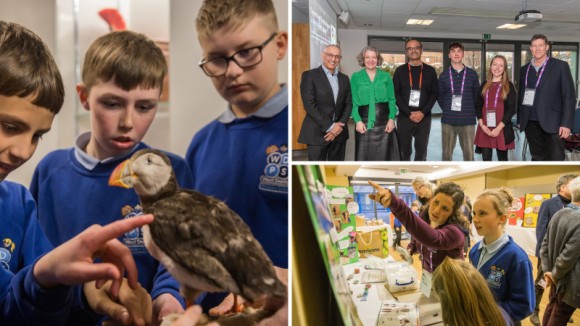
The project has been running for two years, spanning 72 schools throughout North East England and encouraging children to take part in outdoor activities such as planting wildflower meadows and using camera traps to monitor wildlife in their school grounds. During this two-year span, the BES Encounters Platform was also created, which provides lesson plans and worksheets among other ecology- and environment-based resources available to teachers.
All teachers involved with the project agreed that it improved and strengthened the children's knowledge of nature and connection to the natural world.
The celebration event took place at the Hancock Museum in Newcastle, and was attended by Yadvinder Malhi and Hazel Norman (President and CEO of the BES, respectively); Professor Karen O'Brien, the Vice Chancellor of Durham University; as well as teachers, schoolchildren and volunteers from the project.

Left to right: Shaid Mahmood and Karen O’Brien (Durham University), Yadvinder Malhi (BES), Thomas Williams (Durham University; project volunteer), Sammy Mason and Phil Stephens (Durham University and MammalWeb).
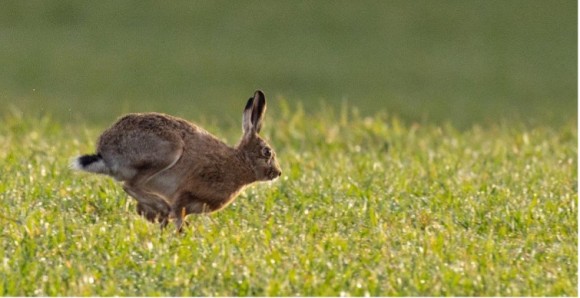
Photograph of hare galloping through the morning dew
Photographer and Professor Steven Lindsay, an early contributer to MammalWeb, has sent through some wonderful images and words about Mad March Hares:
March is traditionally a busy time for hares, it’s the breeding season. Normally solitary they come together in small groups at this time of the year. I’ve not photographed these magical creatures before and was keen to get close them. So, in the cold and dark of the dawn, I stumbled alongside a hedge, next to a field where I had seen hares the previous evening. To my disappointment, in the twilight, I couldn’t see any hares in the short winter wheat, only ten or so large rocks clustered in the middle of the field. And then, one of the rocks moved – my heart raced and I held my breath. I slid slowly down on my belly in the wet and mud on the edge of the field and focused my camera on the hares through the stubble at the field’s edge. What a thrill to see such stunning wild animals grazing in the sparkling dew, lit by early morning light. As the field began to warm and the dew began to clear, the hares became frisky. Every so often, one would sprint at its neighbour and before long, there was a whole lot of uncoordinated sprint training going on in front of me. Hares would run around in small sharp circles before suddenly breaking and going back to nibbling grass. The girl hares were clearly unimpressed with these bursts of enthusiasm, they weren’t ready for mating yet, and ran off and cuffed a few amorous boys that got too close. Eventually the hares left the field with their peculiar slow, looping gait and left me behind wet and muddy, elated by the morning’s entertainment.
Steve Lindsay
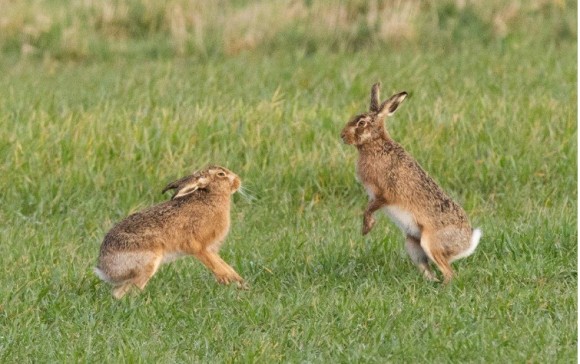

Top: hares sparring, Bottom: Presumably, male hares chasing after a female hare
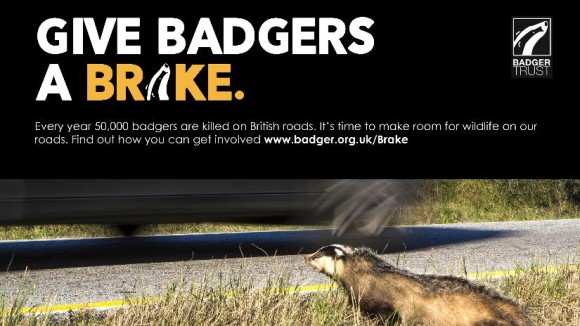
Badgers are considered to be the no.1 mammal killed in road collisions throughout the British Isles, with an average of 50,000 road deaths, annually. These collision rates peak in spring and Autumn, with the period from March to May being a dangerous one for road-going badgers. This is because, during spring, there is a rise in numbers on the move, with cubs being born and sows venturing out for food, as well as young boars being encouraged to leave the sett and establish themselves elsewhere.
The Badger Trust run the ‘Give Badgers a Brake’ campaign, urging drivers and wildlife enthusiasts to slow down, report casualties and raise awareness. Slow down means encouraging due vigilance when travelling on rural roads, particularly at dawn and dusk. For reporting fatalities , the Badger Trust provides an easy link to report via their website, as well as guidance for how to check if the badger is a lactating sow. Drivers and pedestrians, alike, can get involved to raise awareness in person and online using hashtags #GiveBadgersABrake and #Stop4Brock.
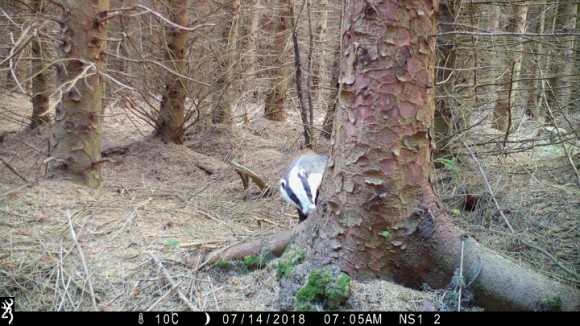
The information gathered by responses and reports is being used with the aim of working with planners and developers to increase mitigation against wildlife collisions on the road and allow our wandering mammals safer passage.
More details on the campaign and how you can help can be found here.
Earlier this month, Sammy made an appearance on the BBC's "The One Show"! The segment was shown on the 7th of March, and is still available to watch on BBC iPlayer, with MammalWeb featuring at around the 14 minute mark, before a segment on the fantastic new David Attenborough show "Wild Isles". Sammy talks about the accessibility of camera trapping and how it can give insight into the hidden worlds around you, with some fantastic footage being shown to top it off.
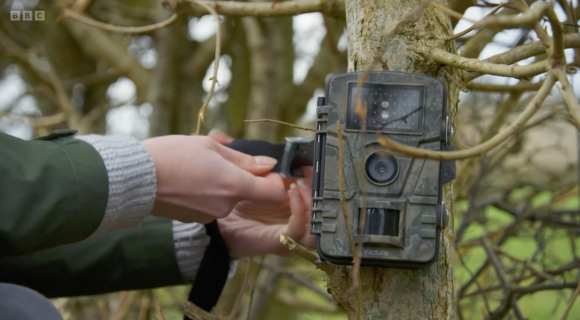
Still of Sammy setting up a camera trap from BBC's the One Show
For those of you who want to watch, the episode is available here via BBC iPlayer.
An update on the SavingWildcats’ breeding for release programme
NatureScot have granted a licence for the Saving Wildcats programme to release captive-bred Wildcats into the Cairngorms in 2023. Scottish wildcats are an isolated population of European Wildcats, and the Scottish population is currently classed as ‘inviable’ due to issues with persecution, habitat loss, and hybridisation with feral cats.
Saving Wildcats is the successor to Scottish Wildcat Action, which was set up in 2015 with the intention of creating a captive breeding programme to bolster the wild population of cats. This year sees the culmination of that breeding programme. In 2022 there were 22 kittens born in the Highland Wildlife Park’s breeding-for-release centre, with these being the candidates for the first release that is currently planned for June of this year.
NatureScot say that the partnership with Saving Wildcats plan to release around 20 wildcats per year into selected areas of the Cairngorms National Park, with GPS collars for monitoring their progress.
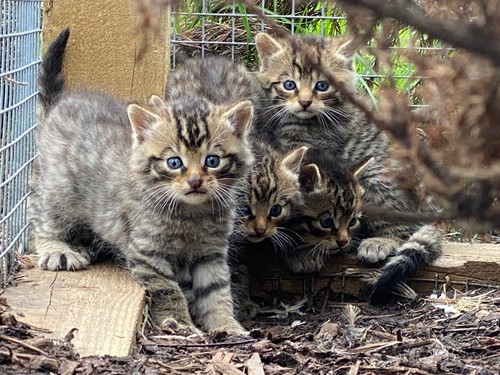
More information on the project can be found here, and information on the licensing and partnership with NatureScot can be found here. Remember: if you live around potential wildcat habitat, you can still contribute valuable camera trap data via our Scottish Wildcats project.
Congratulations to Dr Sammy Mason
Many contributors to MammalWeb will know Sammy through email correspondence, events, talks and media appearances. This is just a quick note to congratulate her for passing her PhD viva in March! Sammy’s thesis was on 'Monitoring the UK’s terrestrial mammals using camera traps: from the field to the classroom’.
Many of you will already know about the aspects of her thesis that involved a systematic camera trapping survey of County Durham and led to this paper. Many of you will also be aware that Sammy implemented a study of how camera trapping could be used to enhance knowledge of local wildlife and more general environmental awareness among schoolchildren. Sammy went on to develop that angle in the context of the British Ecological Society’s hugely successful ‘Connecting schools to nature’ project (see above), which Sammy helped to run.
Overall, Sammy has been an amazing asset to MammalWeb ever since she started her PhD. We hope she will continue her association with the project - and we congratulate her on her well-deserved doctorate!
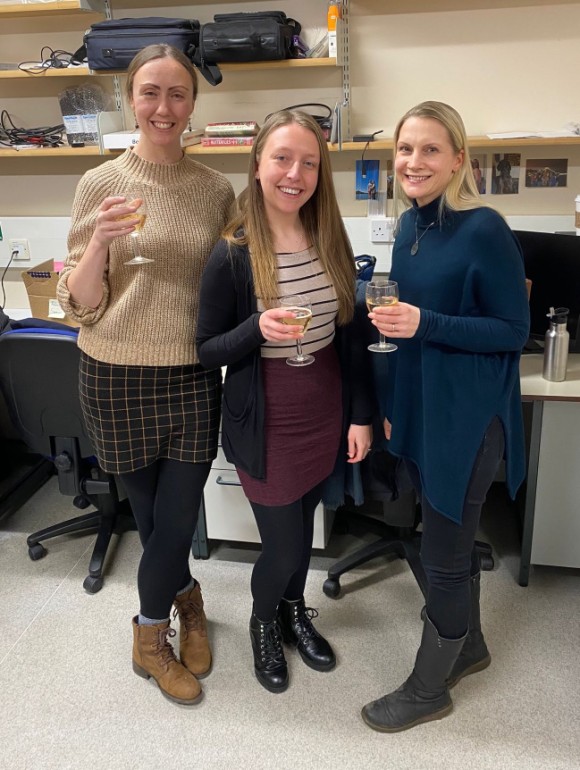
Sammy celebrating with her two examiners, Dr Rachel White from Brighton University and Dr Rachel Kendal from Durham University
Talks and Events
Below are some events and talks coming up. With a mixture of in-person and online events we hope there is something for everyone to enjoy. For even more opportunities, be sure to look at reserves and sites local to you, there are many opportunities for Easter related activities throughout the month!
To celebrate the emerging springtime badgers, this month’s mammal fact is all about the chunkier side of the mustelid family. Badgers are members of the family Mustelidae, which includes otters, stoats, weasels and wolverines, among others. The ‘badger-like’ mustelids represent the most basal members of the species, with American badgers (Taxidea taxus) thought to be the closest to the ‘original’ or oldest mustelid species. There is a distinct difference between the shapes of the long weasel-like members of the family, and the more bear-shaped badgers and wolverines.
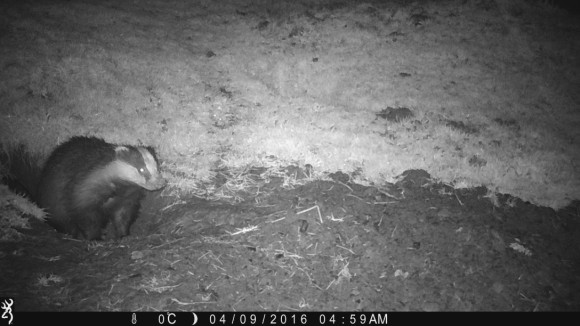
Night-time footage of an inquisitive badger
Well done to everyone who spotted the Pine Marten (Martes martes) lurking in the right-hand side of last month's camera trap quiz! This mammal can be identified here by its size, distinctive curving spine and large dark tail.
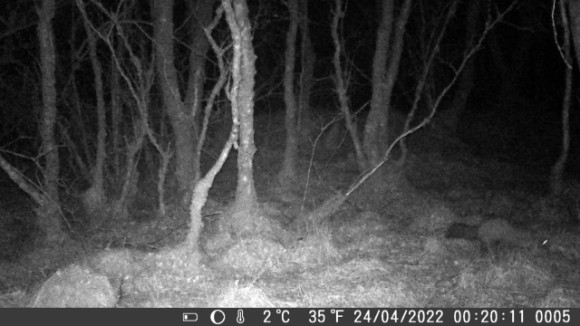
Can you identify the species present in this month's picture? Let us know!
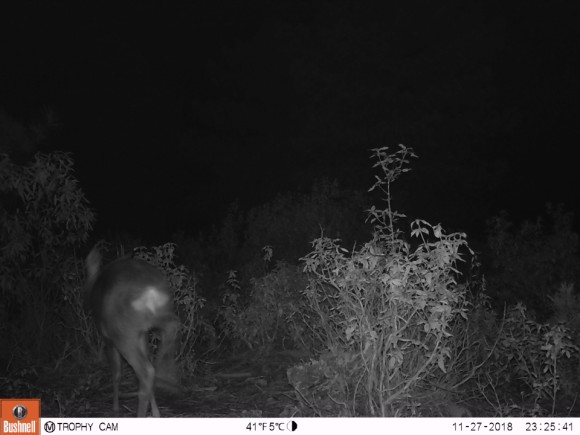
Remember, if you enjoy the camera trap quizzes and want to try some more, we do one weekly on our social media! These are posted across our Twitter, Instagram and Facebook accounts.
Published on February 28th 2023
Welcome to the February edition of the MammalWeb Newsletter! We hope that you are all enjoying the gradual thawing of the winter frost and are excited by the prospect of the increasing activity of our wildlife this Spring.
Now that the seasons are beginning to change, we can expect to see some more diversity and colour when venturing outside. In this issue, we will be sharing some exciting mammal emergences to look out for in March, as well as a spotlight on our MammalWeb at Deerbolt project. In addition, we are announcing the winner of our Festive Competition, and sharing some contributions from our MammalWeb participants. Lastly, as always, we have some exciting upcoming talks and events, a Monthly Mammal Fact and our monthly Camera Trap Quiz!
We love hearing from you - so if you have any comments, queries, insights, or suggestions for next month’s newsletter, then please contact us at info@PROTECTED.
| Number uploaded | Number classified |
|---|---|
| 2735 | 8121 |
These values include all photos from the general MammalWeb Britain project, and our other public projects.
We would also like to highlight that in the last few days, we have passed half a million classified sequences! This is a huge milestone! Congratulations to Jo Young for classifying our 500,000th sequences - and a massive thank you to our contributors for getting us to this number.
Congratulations to our top ten spotters in January! We very much appreciate everyone’s hard work!
| Position | User |
|---|---|
| 1 | Rochesterj |
| 2 | Checchi |
| 3 | PetaSams |
| 4 | Mike King |
| 5 | Deacon |
| 6 | Florian |
| 7 | NWKCP |
| 8 | Kyshiara |
| 9 | LucasHill07 |
| 10 | SusanThomas |
Brief erratum from January Newsletter:
In our round-up of 2022, more eagle-eyed contributors might have noticed that the data showed 62357 sequences contributed but only 802 sequences classified. That number would suggest that we will be falling ever further behind with classifications! In fact, this was a typo; the real number of classifications should have been 80284. We obviously really appreciate the hard work that led to that number, substantially outstripping the number of newly uploaded sequences!
Announcement of Festive Competition Winners!
Congratulations to the winners of our Festive Competition, Jonathon from Barcelona, and Laura from Oxfordshire! Jonathon and Laura have both won a camera trap, which is currently on its way to them in the post. We very much look forward to seeing what they capture, on MammalWeb, in due course! We would also like to say a massive thank you to everyone who has uploaded sequences and submitted classifications to the MammalWeb projects.
March Mammals
March brings much change for our wildlife, as the cold of winter begins to fade, and a new season commences. At the beginning of spring, much is awakening in the mammal world to keep your eyes peeled for!
Foxes
Most female foxes, or vixens, will be having their cubs at the beginning of March. While it will be another four or five weeks before the cubs appear above the ground, vixens and their mates might be seen hunting in the daytime to feed their hungry cubs, with nursing vixens being easily identifiable by their visibly swollen teats. Interestingly, in densely-populated areas such as cities, where foxes live in extended family groups, a vixen’s relative may also help out with the hunting and might even act as a wet-nurse for her cubs!
Deer
Red and fallow deer will begin to lose their antlers at the beginning of March. Roe deer bucks are still in the final stage of antler development in early March, but will begin to shed their antlers in the next few weeks!
Badgers
Much like foxes, badger females, or sows, will be giving birth in February and March. As badgers do not store food for the future, or benefit from the helping hand of a relative, these new mothers are forced to leave their cubs to forage for food out in the open.
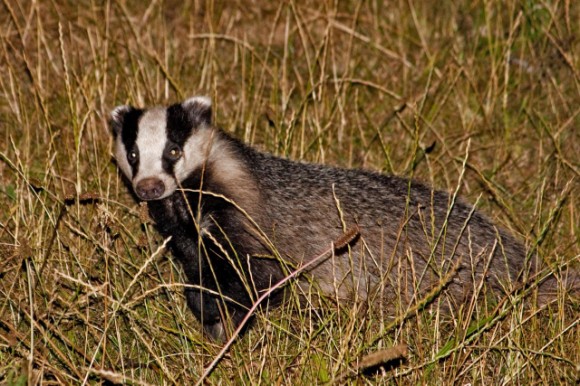
(C) Mark Robinson (shared under a CC BY-NC 2.0 license)
Hedgehogs
It is time to clean out and fill up your hedgehog feeders and put out some fresh water, as hedgehogs will be coming out of hibernation in March! Usually, male hedgehogs will be the first to leave their leafy nests and go on the hunt for food and water in order to start the process of replenishing the fat reserves that they have lost over the winter.
Brown Hares
Although hares have been boxing and chasing, their typical breeding activities, during both January and February, March is the best month for naturalists to observe this behaviour. This is because the days are growing longer, meaning that this behaviour is no longer restricted to nighttime. Boxing usually occurs when a male (buck) is being too persistent with a female (doe), often chasing her across fields in an attempt to mate. When the doe has decided she’s had enough of the bucks’ advances, she will turn around and fend him off in a ferocious boxing match!
Water Voles
Small mammals are beginning to be active again, including water voles which are now exiting the burrow systems to which they have been largely restricted in winter. Keep your eyes peeled along riverbanks and canal sides for water vole activity in March!
Spotlight on: MammalWeb at Deerbolt Project
Deerbolt is a Prison and Young Offenders Institution in County Durham, near Barnard Castle. The prison is set next to Deepdale Wood nature reserve, an ancient semi-natural woodland through which the Deepdale Beck river flows. The nature reserve is managed for nature conservation, boasting a diverse array of woodland wildlife.
MammalWeb partnered with HM Prison Deerbolt to support its ambition of being Britain's “Greenest Prison”, with an aim to embed a culture shift amongst staff and the prison population, towards environmentally sustainable behaviours.

Image of HMP & YOI Deerbolt
An interactive MammalWeb touchscreen information source has been installed in the visitors' centre, which allows visitors to classify camera trap footage from camera traps in the habitat surrounding the prison, as well as being able to classify MammalWeb Britain images too. The aim is to allow visitors to learn about local wildlife and to provide an enriching experience to anyone visiting the prison. Longer term, the aim is to develop the facility into a "Wildlife Community Engagemetn Hub" used for a wider range of community activities.
The strategy was not only designed to have a positive impact on visitors and the local environment, but also to create a project on which the young men and staff of Deerbolt Prison can work together. For example, residents have created camera boxes for small mammal monitoring as well as planters with hedgehogs houses in their workshops.There is a growing body of evidence to suggest that working with plants and animals can boost the wellbeing of prisoners, increasing their connectedness with nature, and having a positive impact on their futures.
This month, we wanted to put the spotlight on the MammalWeb at Deerbolt project to highlight the potential benefits that projects such as these can have for local communities and environments. As well as this, we think that spotting for this project is rather uplifting! There are some really lovely videos to classify, that are often coupled with the serene sounds of birdsong and the Deepbale Beck flowing in the background. In sharing a project that we love to spot for, we would love to hear from you about which projects you like spotting for best, and what makes those projects enjoyable for you?
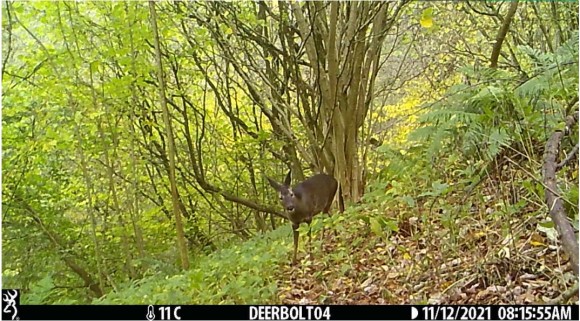
Camera trap image from MammalWeb at Deerbolt Project
Recently, a user notified us that the MammalWeb at Deerbolt project does not appear to work fully in the FireFox browser. The team are currently looking into this issue, so fear not, FireFox users, as this will be back up and running soon! We greatly appreciate being informed of these problems, so do let us know if you ever run into any technical issues on the site and we will do our best to get them fixed as fast as we can.
Contributions from our Participants
The Western Jackdaw - Courtesy of Mark from Avibirds
Thank you to, Mark, from Avibirds, who has recently contacted us to share an interesting video with a lot of useful information about the Western Jackdaw. Mark highlights the distinctive colour of the Jackdaw’s irises in his video, making us wonder how often Jackdaw iris colouration can be detected in camera trap images. Follow this link to watch the video.
Carnivores of Wester Ross – courtesy of trapper Richard Meyer
Thank you to trapper Richard, who has recently sent us some of his camera trap pictures from around his home in Wester Ross, Scotland. What a place! We love seeing the pictures that our contributors send in – so please do send any that you think we might enjoy, especially if we might be able to share them with all our participants!
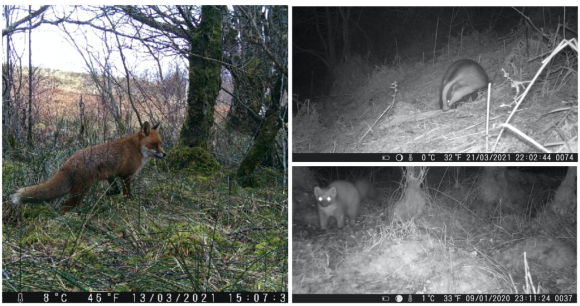
Upcoming talks and events
Below are some upcoming events and talks for everyone to enjoy around the UK. If you’re eager to attend even more wildlife events, there are plenty more opportunities for outdoor learning and activities advertised on the Wildlife Trusts event page for the coming months.
Monthly Mammal Fact
Weasels are a predatory mammal, preying primarily on voles and mice, as well as larger prey such as birds and rabbits. Their long thin shape is advantageous for hunting, as this allows them to follow rodents into their small underground burrows. However, being long, thin, and small means that weasels have a very high surface area to body ratio; inturn, that means that they lose heat rapidly and have to eat very often. The extremely high metabolism of the weasel means that it needs to eat roughly 40% of its own body weight daily. This hefty appetite is particularly interesting considering that the weasel is the smallest member of the order Carnivora (including cats, dogs, and bears) weighing anywhere between 50-195g.
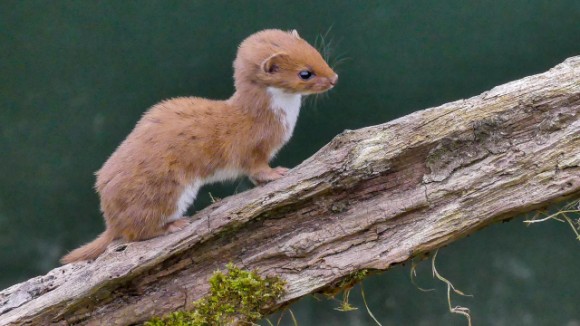
(C) Mike Prince (shared under a CC BY 2.0 license)
Monthly Camera Trap Quiz
Well done to anyone who spotted the redwing in last month’s camera trap quiz, lurking in the bottom left-hand corner of the image! The redwing can be identified by a distinctive creamy strip above the eye and orangey-red patches on it’s flanks. Redwing’s are the UK’s smallest true thrush species and, in the UK, are most commonly encountered during the winter. The redwing is listed as a schedule 1 species in the Wildlife and Country Act, due to the small number of nesting pairs present in Britain.
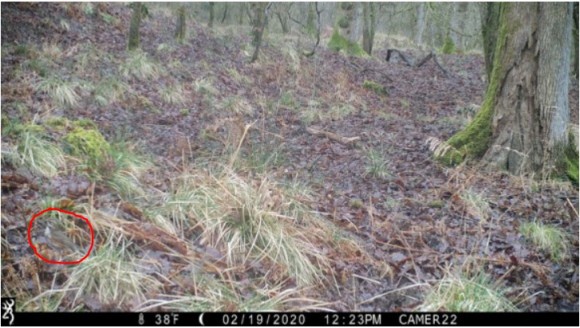
Following on from our previous mention of the delightful footage from Wester Ross, this month we have selected a camera trap quiz photo from those sent in by Richard. Have a good look and let us know what species you think is in this image!
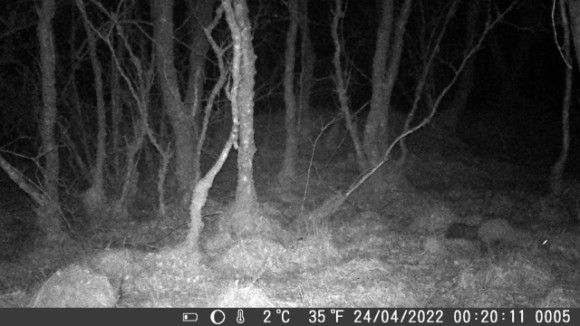
Remember, if you enjoy the camera trap quizzes and want to try some more, we do one weekly on our social media! These are posted across our Twitter, Instagram and Facebook accounts.
Published on January 31st 2023
Hello and welcome to the January issue of the MammalWeb Newsletter! Wishing you all a very happy New Year and hoping that you have all enjoyed some crisp winter weather.
Much of the British Isles may have been covered in snow - but, if it returns, the biting cold does have a silver lining - it gives us an opportunity to see the tracks and signs left behind by any wild visitors! In this issue, we’ll be talking about just that: an overview of some common tracks and signs for winter spotting. As well as this we have a spotlight on birds, some tips for capturing small mammal footage, and an overview of the stats for all of 2022! Plus, as always, a list of upcoming talks and events and our monthly Camera Trap Quiz.
We love hearing from you - so if you have any comments, queries, insights, or suggestions for next month’s newsletter, then please contact us at info@PROTECTED
| Sequences uploaded | Sequences classified |
|---|---|
| 4606 | 4710 |
These values include all photos from the general MammalWeb Britain project, and our other public projects.
Congratulations to December's top ten spotters! We very much appreciate everyone's hard work.
| Position | User |
|---|---|
| 1 | PetaSams |
| 2 | Jotorre |
| 3 | Localherping |
| 4 | Sophie |
| 5 | Visanat |
| 6 | Checchi |
| 7 | Florian |
| 8 | Rustyknight07 |
| 9 | Mike King |
| 10 | Joshin272 |
2022 was a great year for wildlife and conservation. In last month's newsletter we covered some of our achievements over the last year; this month we're going to spotlight what some of you have been busy doing!
Below is a roundup of the stats from 2022, alongside some of the more frequently spotted animals.
| Number of New Spotters | 441 |
| Number of New Trappers | 74 |
| Sequences/Videos Uploaded | 62357 |
| Sequence Classifications | 802 |
| Number of New Projects | 104 |
A massive Thank You to all of you who have contributed to trapping and spotting throughout 2022! You've really contributed some fantastic data and we can't wait to see what is uploaded and classified in the next 12 months.
Below is the list of our Top 10 most identified species from 2022:
| Ranking | Species | No. Classified |
|---|---|---|
| 1 | Red Fox | 5099 |
| 2 | Roe Deer | 4801 |
| 3 | Rabbit | 4573 |
| 4 | Hedgehog (Western) | 3497 |
| 5 | Grey Squirrel | 2970 |
| 6 | Badger | 2492 |
| 7 | Woodpigeon | 1915 |
| 8 | Blackbird (Eurasian) | 1775 |
| 9 | Mouse (unknown species) | 1611 |
| 10 | Wild Boar or Feral Pig | 1503 |
With the exception of the Wild Boar, these are all common species that are found in a wide range across both urban and rural habitats. Interestingly, the Red Fox is in the number 1 position as our most classified species last year. This could be for a number of reasons; the widespread presence of the Red Fox across not only the British Isles but across Europe, as well; the common placement of camera traps in garden spaces, which foxes are known to frequent; or even the bias from camera placement and species monitored in specific projects being classified through MammalWeb. The Wild Boar or Feral Pig taking the number 10 slot is more surprising and could be down to projects such as the Highlands Rewilding project that is using camera traps, in part, to monitor the presence of these animals on-site.
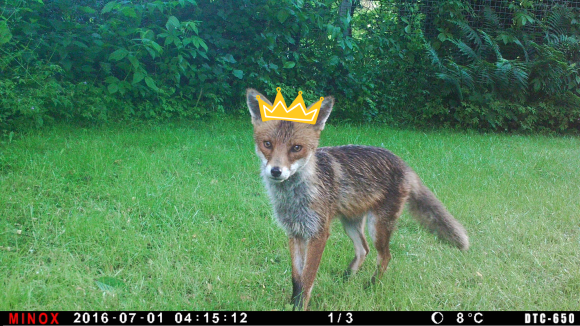
On the other end of the list, nine out of our ten LEAST classified species are bird species. These are: Dunlin, Long-tailed tit, Osprey, Red Grouse (Willow Ptarmigan), Tree Pipit, Tree Sparrow (Eurasian), Brambling, Common Tern, and Red-breasted Merganser. This could be due to the size and speed of birds - particularly smaller birds like the Tree Sparrow or Brambling - being tough to capture without bird-specific camera placements. It's also possible that classifications might represent identification errors. An osprey is possible but buzzards and sparrowhawks are more frequently seen in camera trap footage, and classification errors are not uncommon among the rarely sighted hawks and raptors. The only mammal in our list of LEAST classified species is the Hazel Dormouse. The Hazel Dormouse can be found in the south of England and Wales and is classified as Vulnerable on the IUCN list for these countries. The scarce populations of Hazel Dormouse could be the reason for low classification numbers however number 9 on our most classified species is Mouse (unknown species) - so, on the positive side, there could be plenty of Hazel Dormouse footage out there that's just particularly tricky to classify! For reference, each of the species in our bottom ten was only been classified once in 2022, and we cannot yet rule out mistakes in any of these cases.
Once again a huge Thank You to everyone who has contributed to MammalWeb in any way over the past 12 months. 2022 was a great year for camera trapping. Let's make 2023 even bigger!
If you’ve been keeping up with Winter Watch this year you may have spotted the Greater, White-Toothed Shrew making an appearance. As we’ve mentioned in previous newsletters, these small mammals have only recently been recorded in the UK and are at risk of becoming an invasive species. With the reports so far being over 200kms apart, monitoring on a national level is the best way to ensure we’re not missing any sightings of Greater, White-Toothed Shrews.
There are a few ways you can help with this, and one that may appeal to you as a MammalWeb contributor is small mammal camera trapping! We’ve got a few tips for you here on how to best capture small mammals, based around creating a Littlewood box for small mammal camera traps.
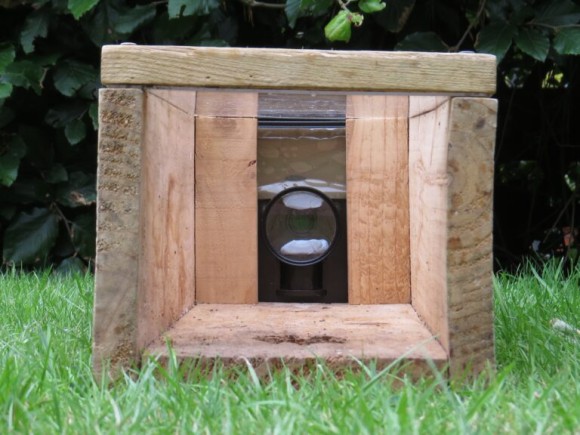
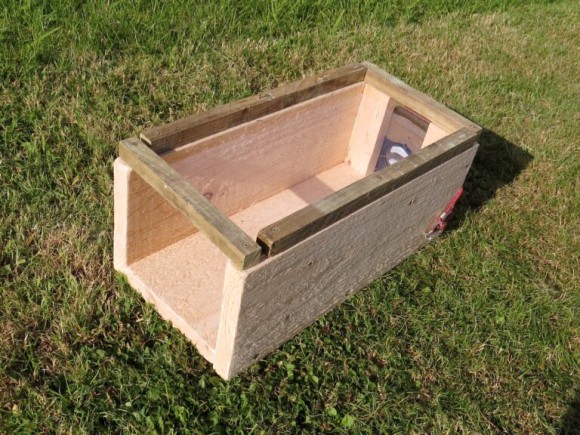
Images of the front and exterior of a Littlewood box for small mammal camera trapping, taken from the guide to making one here.
The Littlewood box consists of a wooden box frame, roughly 40x 16cm, with a clear plastic top to allow daylight in. The camera trap is fixed to one of the ends of the box by bungee cord with the other end left open to form a tunnel in to the camera-trapping area. This open end is how the animals will get in.
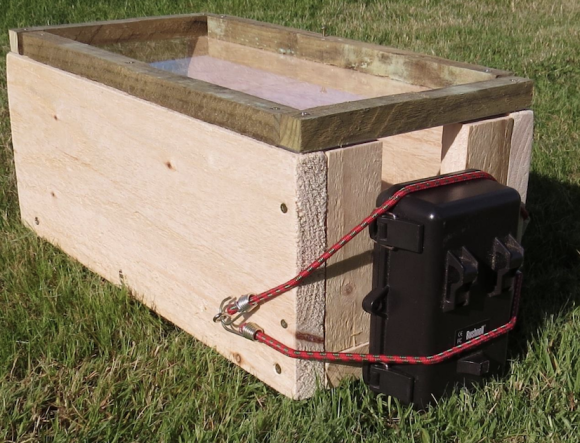
Image of the camera attachment to the Littlewood box by bungee cord.
A +4-focus lens is fixed onto the front of the camera trap with blu-tack in order to get useable footage for identification at such a short range, and the flash is dulled by layers of packing tape over paper.
Bait such as birdseed and dried mealworms is placed in the box about 30cm away from the camera.
This setup allows for good footage of small mammals via camera trap, which is a great alternative to live trapping, a much more intensive method that can have detrimental effects on the animals being caught and released.
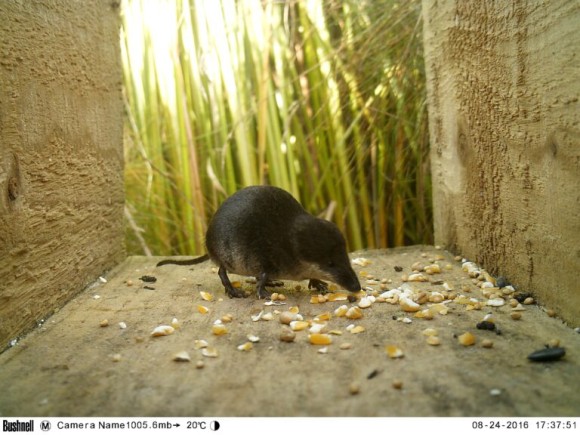
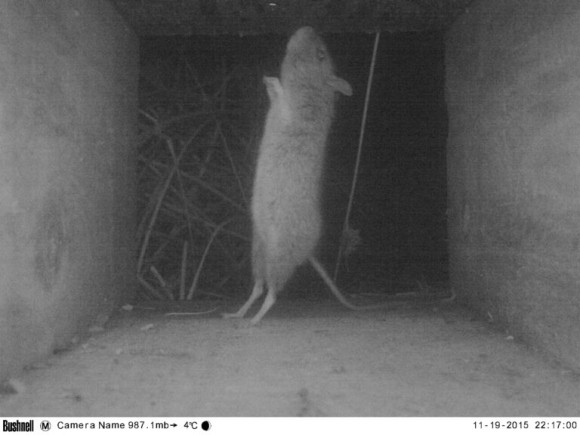
Example images of footage from a Littlewood box for small mammal camera trapping
A more intensive guide to building a small mammal camera trapping box can be found here, and a link to the open access article describing the methods and findings of the Littlewood box can be found here.
When looking at footage, the key ID features for the Greater, white-toothed shrew are their long tail hairs and white teeth, although the latter may not be visible in camera trap footage. Their coat is reddish-brown on top with a grey underside, and they have prominent ears.
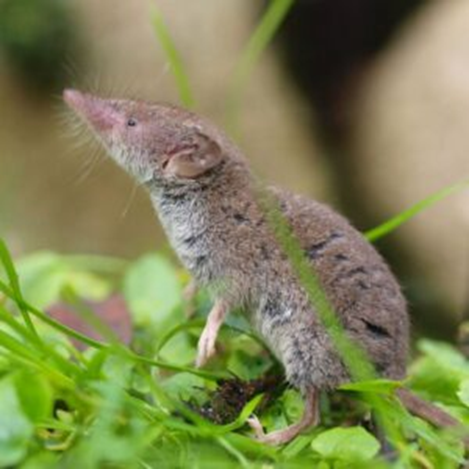
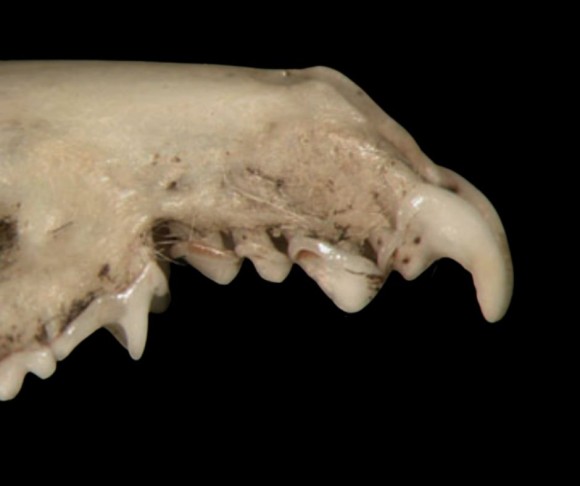
Left: Image of a greater, white-toothed shrew by Rudmer Zwerver, Right: close-up image of the greater white-toothed shrew dentition, note the white teeth rather than the red-tips present in our native shrews. Both images downloaded from the Mammal Society.
Another way to contribute to the hunt for the greater, white-toothed shrew is by examining owl pellets. If you happen to come across any owl pellets in the wild, dissect them to examine the remains within. Our native shrew species all have red-tipped teeth, so if there are any shrew remains with teeth that are pure white then they belong to the GWS.
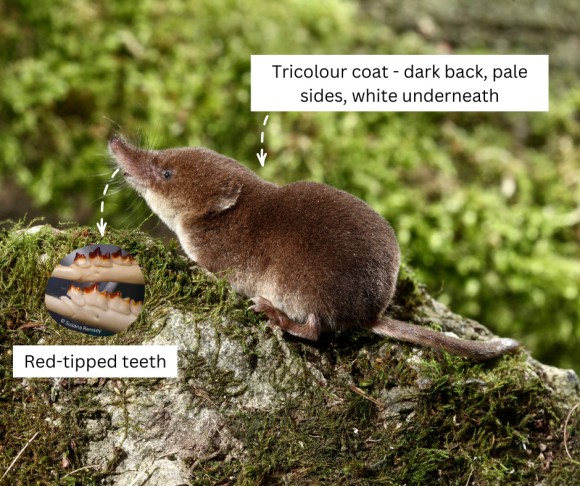
Image: Common Shrew, with key ID features labelled. Note the red-tipped teeth and compare to the white dentition shown above.
Please record any shrew sightings through the mammal society’s free Mammal Mapper app, and upload any small mammal camera trap footage to us at MammalWeb. As always, if you have any further queries or need assistance with the process, send us an email at info@PROTECTED - we're happy to help.
Although we focus on the mammal side of things, the footage classified by our wonderful citizen scientists often captures other species as well. Namely, birds! The British Isles have a wide variety of bird species, some more common than others, and these are frequent visitors to our screens via the multitudes of camera traps placed by you.
The RSPB have been hosting the Big Garden Birdwatch over the last weekend in January, so this month seemed like the perfect time to give our birds sometime in the spotlight! Keep an eye out through the RSPB for the Birdwatch results, they're a fantastic resource for looking at population trends over the years.
Most common birds classified (of all time):
| Ranking | Species |
|---|---|
| 1 | Blackbird (Eurasian) |
| 2 | Woodpigeon |
| 3 | Pheasant (common) |
| 4 | Great Tit |
| 5 | Jay (Eurasian) |
| 6 | Carrion Crow |
| 7 | Robin (European) |
| 8 | Magpie (Eurasian) |
| 9 | Chaffinch |
| 10 | Song Thrush |
An unsurprising top ten there, as all of these are common garden birds, but what a wonderful selection there is! Below we've got some great examples of footage of these species, as well as some extras we couldn't miss out.
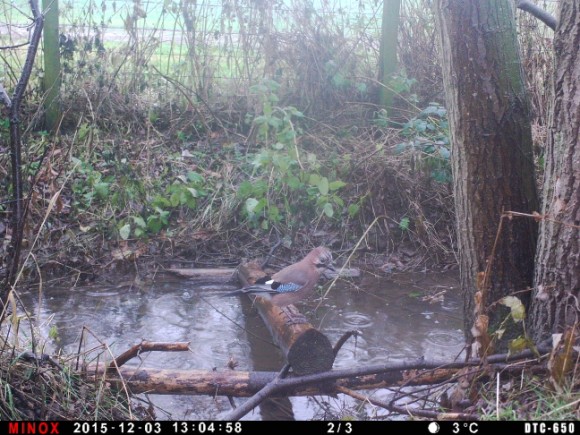
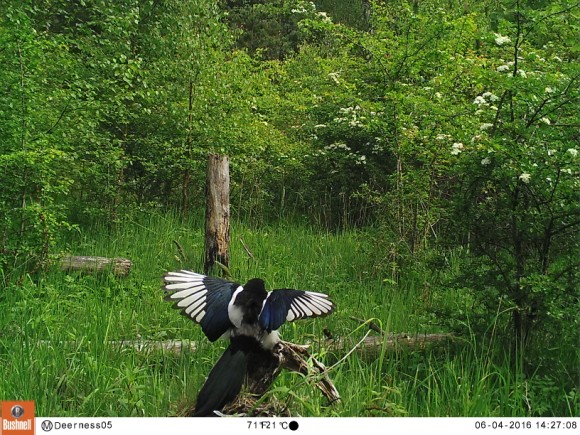
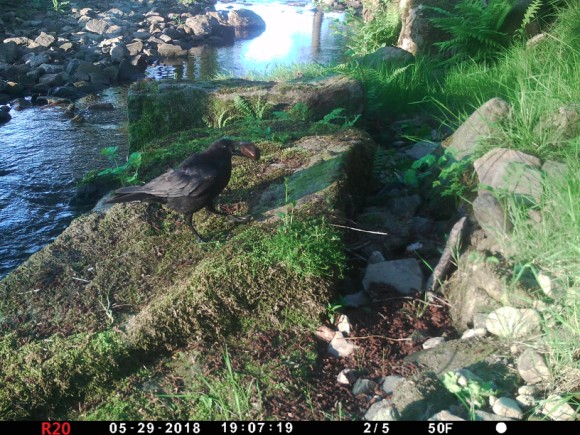
A collection of corvids with Jay (top), Magpie (middle), and Carrion Crow (bottom).
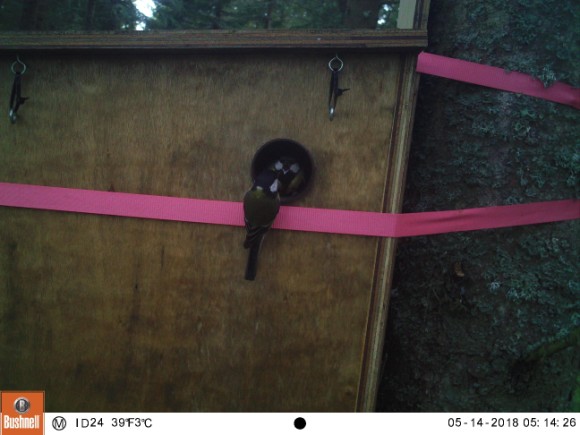
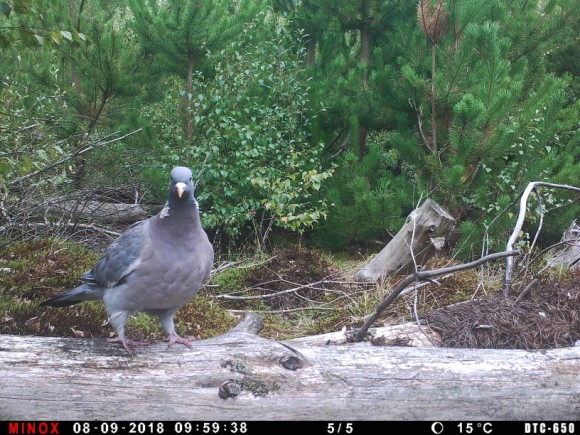
Two Great tits conversing at the entrance to a nestbox (top) and a Wood Pigeon looking perplexed at the camera (bottom)
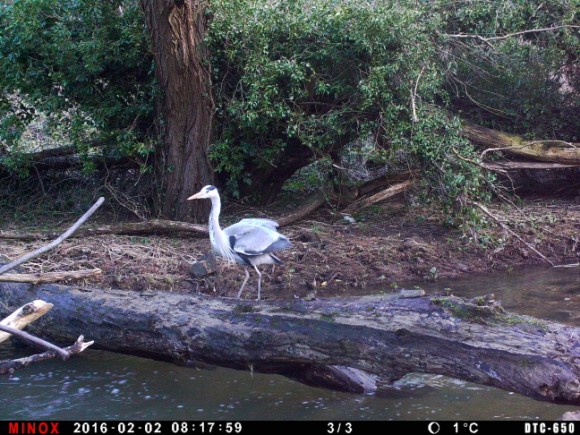
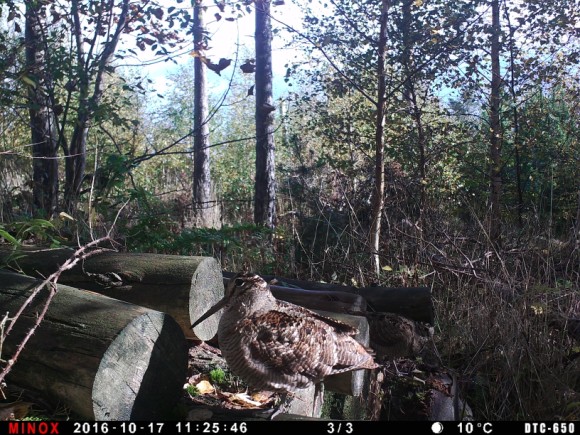
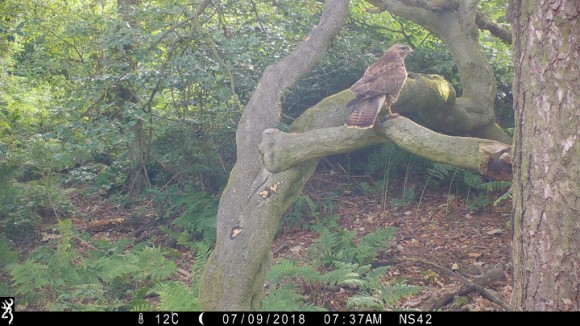
And for a little bit of extra bird footage: a Grey Heron (top), a Woodcock (middle), and a lovely Common Buzzard (bottom).
For camera trappers who are also bird enthusiasts, there are a few ways that camera traps can be set up specifically to get a closer look at the birds in your garden. If you set up the trap with a good view of a feeder this often works; however, loose feeders will swing in the wind, triggering the camera and rapidly filling up memory cards. To avoid this, consider focusing your trap on a stationary feeding area like a bird table, or modifying your hanging feeders to minimise swinging.
A note on avian flu: much of the UK is being affected by avian flu. This is predominantly affecting seabirds and poultry, with far fewer cases involving garden birds. However, the government guidelines do err on the side of caution. While it is perfectly fine to continue to put out food for garden birds, the recommendation is that any feeders and birdbaths are regularly cleaned and disinfected. More information on the full government guidelines can be found here, and tips for cleaning feeders can be found here.
Snowy ground and frosty mornings are perfect for spotting tracks and trails left behind during the nighttime wanderings of our native mammals. Although the animals themselves may be seldom seen, these tracks can show us what wildlife shares our spaces. Reading tracks and signs can also give us hints towards good locations for camera trapping as areas that have frequent animal ‘roads’ through them will no doubt be high-activity sites.
But how do we decipher these tracks? When looking at a set of tracks in isolation it can be difficult to distinguish one set of prints from the next. There are a few tips for distinguishing between, for example, feline and canine tracks, which can often be less distinct to the untrained eye. It is also important to look at other signs around the tracks, is there scat? Hair? All of these elements can help to uncover what species has been travelling through the area.
There are as many different mammal tracks as there are species - so, here, we're going to look at some of the most distinctive that you may find throughout the British Isles.
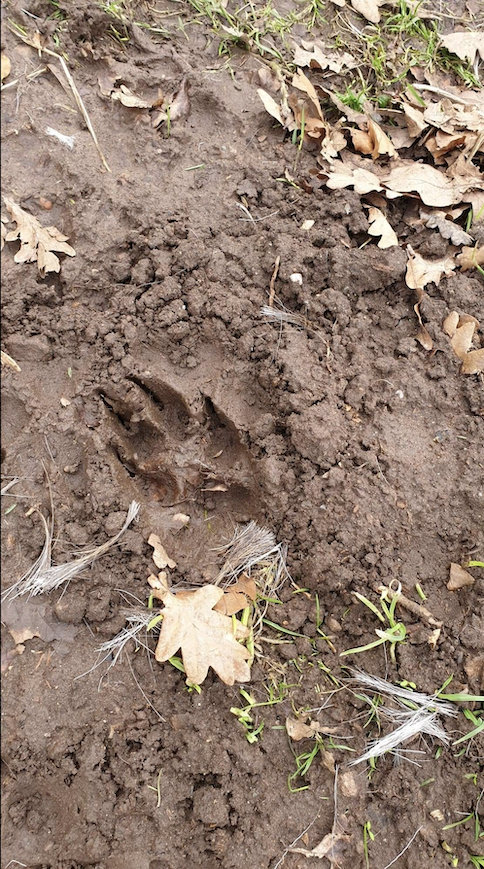
A good example of a canine track, with the clear 'x' between the toe pads and visible claw marks forming points at the toes.
Canine tracks have four toe pads and a double-lobed palm pad. In dogs this ‘palm pad’ is significantly larger than the toe pads, but in foxes it is of similar size.
Canine tracks have an ‘x’ or ‘h’ shape passing through the pads but fox tracks tend to be roughly 3x5cm whereas dog tracks vary wildly in size. Foxes walk in clear, straight lines, so a straight line of tracks with a frequent ‘double register’ from the back paws walking over the front prints would point towards a fox trail rather than dog, as dogs will generally move in a more scattered, meandering manner. There are also often claw points visible in canine prints, as their claws are non-retractable.
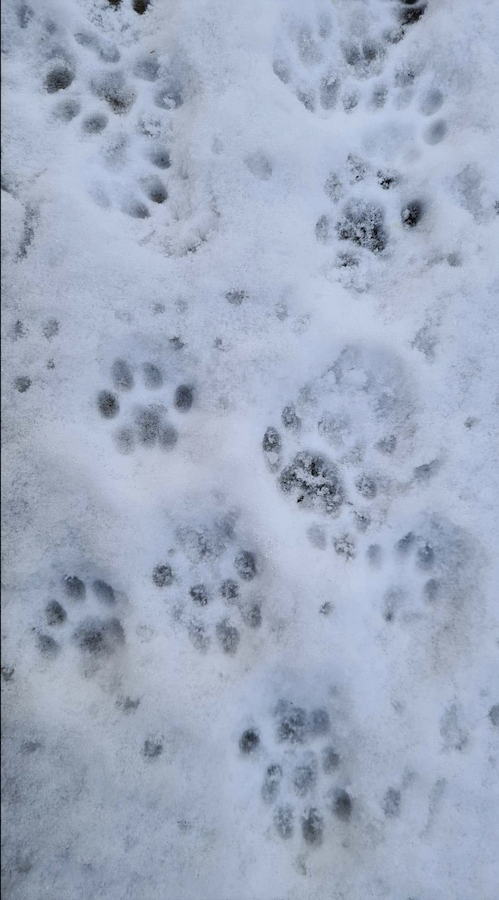
A plethora of feline prints, note the three-lobed palm pad and no claw marks.
Feline prints have four toe pads with no visible claw points showing as their claws retract when they walk. The space between the toe pads and the palm pad is more ‘c’ shaped, and the palm pad has three lobes rather than the two on a canine print.
Domestic cat prints are the most common feline prints in the UK; however, in some areas in the highlands, it is possible to find wildcat prints. Wildcat prints these are generally not distinguishable from domestic cat prints in isolation, and further identification methods (such as camera trapping) may be necessary for identificstion. Ultimately, Scottish wildcats have been subject to so much interbreeding with domestic catsm that genetic analyses might be the only way to decide which of these any individual should be assigned.
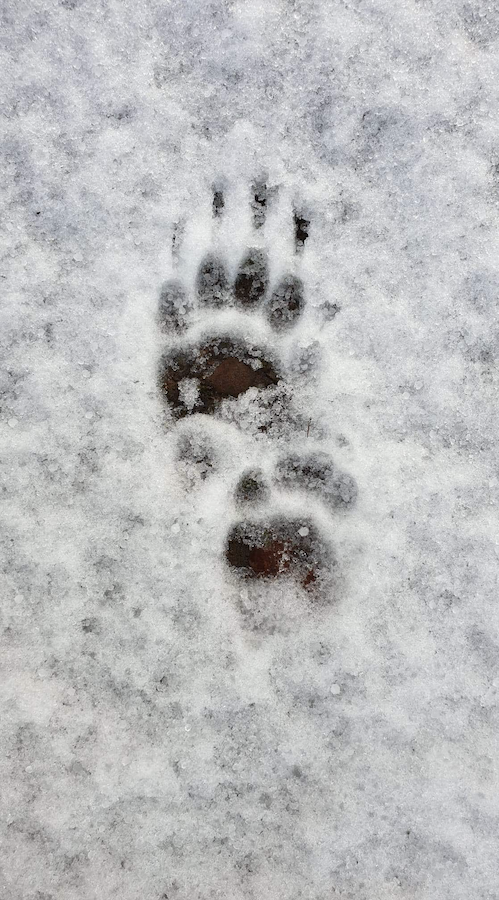
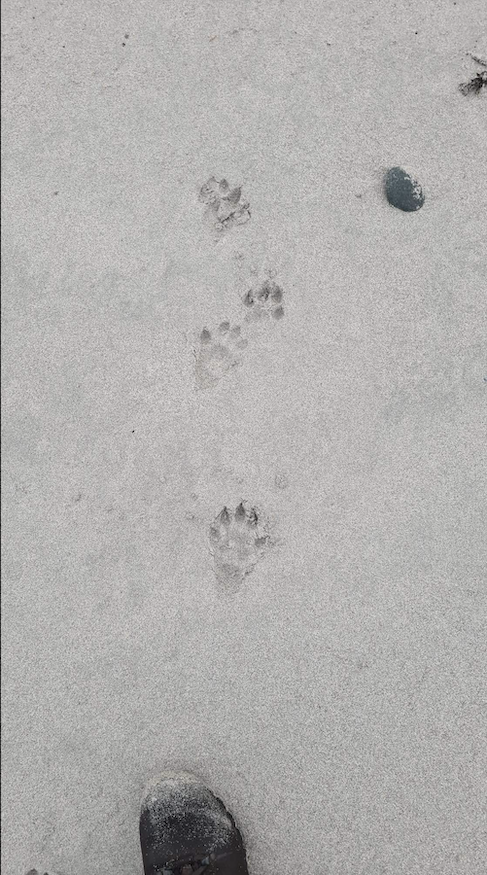
Badger tracks (left), and Eurasian Otter tracks (right), showing an example of the variety between mustelid species, athough no visible tail-drag can be seen in the image of otter tracks.
Prints from the various mustelid species across the British Isles are quite distinctive, ranging from the almost bear-like badger prints to the tiny star-shaped prints of a weasel. Badger prints are the most distinctive as they look almost like miniature fist prints with distinct claw marks. Otter, mink, and weasel tracks are more like each other. For these species, size can sometimes be a good indicator, but often among smaller mustelids other methods of identification may be necessary. Look for other animal signs nearby and inspect the negative space between the tracks as well. Often when it is particularly wet you can see the distinctive tail drag between otter tracks.
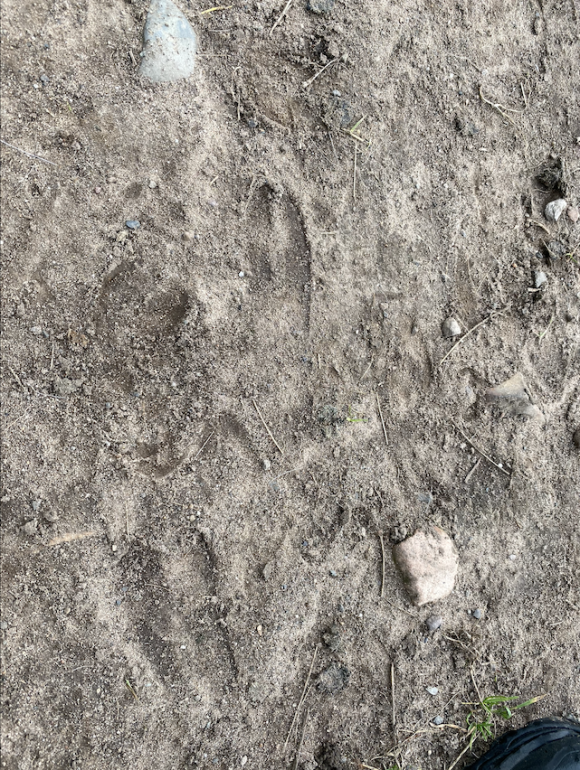
Image of fallow deer tracks, note the narrow and pointed shape.
In contrast to all of the above, ungulates like deer and sheep leave entirely different tracks altogether. All show a cloven hoof print, but those of a deer tend to be narrower and more pointed at the top than sheep. Deer tracks will also be found in a variety of habitats, primarily woodland, whereas sheep in the lowlands tend to be in fenced-off areas.
There's plenty to see out there at this time of year, so next time you go for a walk why not keep your eyes on the ground for part of it! There are some more handy tracking guides here, and even a fold-out ID sheet from the Field Studies Council here. If you find some good tracks, you can always try making a plaster cast with this handy guide from the RSPB.
Talks and Events
Below are some events and talks coming up. With a mixture of in-person and online events we hope there is something for everyone to enjoy. For even more opportunities, be sure to look at reserves and sites local to you.
The fastest growing mammal tissue is deer antler! Antler, unlike horn, is made of bone and goes through an annual growth cycle. A typical cycle for most species will start with the growth phase (kicked off by increased testosterone production), during which the antlers are covered in velvet - a layer of furry tissue that provides the growing bone with ample nutrients. The antlers will stay 'in velvet' until the bone underneath is fully hardened, after which the velvet will be shed and the deer will be in 'hard antler', ready for the rut. The deer will then keep the antlers over winter and cast them when testosterone levels drop in spring. Growth will start again almost immediately, and the cycle begins anew. The seasonal cycle depends on species, with some species growing and casting more than one set of antlers in a year!
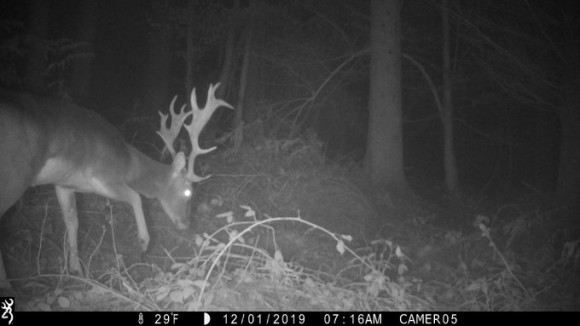
Fallow buck with impressive palmate antlers
Well done to everyone who managed to identify the female Red Deer (Cervus elaphus) in last month's camera trap quiz! Red deer are one of the two deer species native to the British Isles, and in this case the female can be identified by the two-colour patterning of her coat, lack of distinct tail or rump markings, and 'buff' beige rump patch, rather than the smaller whiter patch present in roe deer.
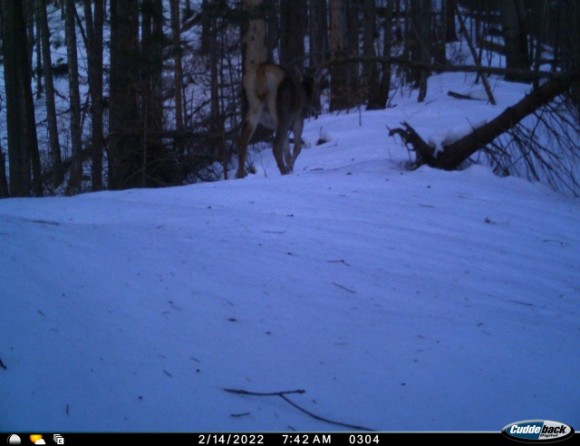
We've got a topical quiz for you this month, have a good look and let us know if you spot the species hiding in the image!
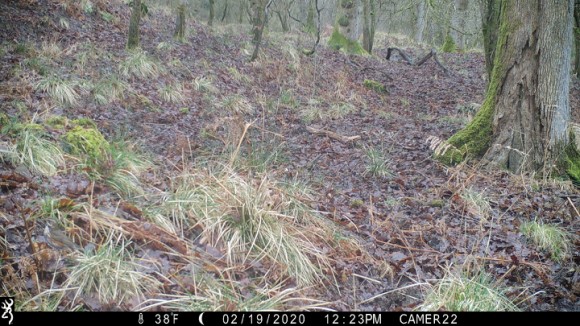
Remember, if you enjoy the camera trap quizzes and want to try some more, we do one weekly on our social media! These are posted across our Twitter, Instagram and Facebook accounts.
Published on December 31st 2022
Hello everybody and welcome to the December issue of the MammalWeb Newsletter! We hope that the festive period has been enjoyable for all and that it has given most people a much-needed opportunity to unwind.
As the stark winter weather has well and truly taken its hold over the UK, and our wildlife has slowed down, migrated somewhere warm for the winter, or gone into hibernation, our great outdoors can seem slightly barren and lifeless and motivation to get outdoors can wither. However, there are still golden nuggets of hope provided by what winter wildlife we do have, such as the captivating murmuration’s of starlings at dusk and the sound of foxes barking in the night.
In this months newsletter, we have gathered some highlights from the past year that the MammalWeb team are particularly proud of. As well as this, we have an update on the status of the Greater White Toothed shrew in the UK and a festive competition to show our gratitude for the excellent work of our avid contributors. We also have some important information about website changes and alterations to our Terms & Conditions. Finally, as always, we have a list of exciting upcoming talks and events, our Monthly Mammal Fact and Camera Trap Quiz!
We love hearing from you, and if you have anything that you would like us to include in next month’s newsletter, please get in touch at info@MammalWeb.
| Number uploaded | Number classified |
|---|---|
| 3048 | 5202 |
These values include all photos from the general MammalWeb Britain project, and our other public projects.
Congratulations to November's top ten spotters! We very much appreciate everyone's hard work.
| Position | User |
|---|---|
| 1 | saeedbinkaiban |
| 2 | Pilar Clapers |
| 3 | BunnyRose |
| 4 | gcsmith |
| 5 | RustyKnight07 |
| 6 | gaymansam |
| 7 | MartaPS |
| 8 | Mike King |
| 9 | vivcoy |
| 10 | Quinngrace_10 |
As 2022 draws to a close, there are many achievements to reflect on and champion from the year that has passed. We would like to emphasise that the input of our amazing contributors is paramount to the success of the project, and therefore express our gratitude to all those who have contributed since the project’s inception. The following are a few achievements we are particularly proud of from the past year:
In recognition that this is a time of year for giving, we are going to be giving away 2 camera traps as belated Christmas presents to our avid spotters. Every classification that you submit between the 25th of December and the 25th of January will count as one entry into a prize draw. So, the more sequences you classify, the higher your chances are of winning! After the 25th of January, we will draw the 2 lucky winners at random and contact them to arrange the delivery of their camera trap awards. Good luck spotters!
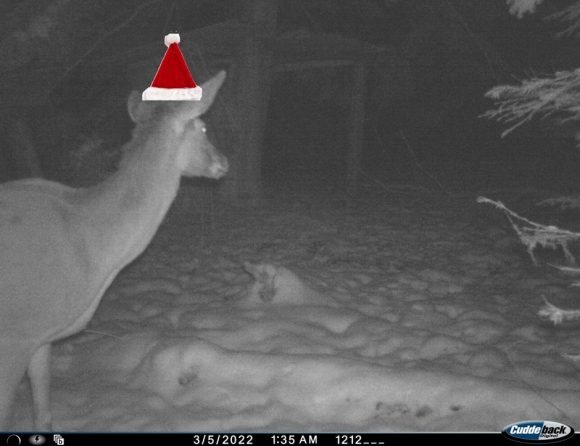
Our incredible website designer has been working on some site changes to improve the usage of the MammalWeb website. Including:
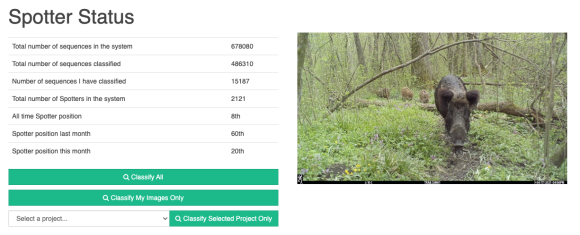
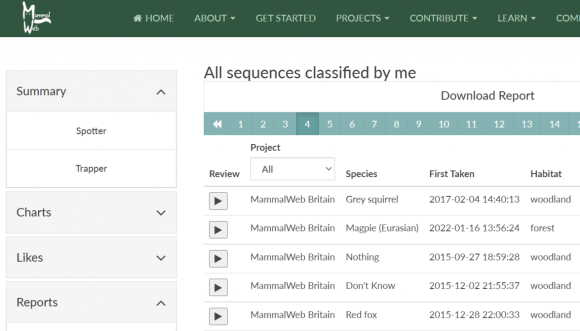
We have just updated our terms and conditions to note that site locations will now be shared with biodiversity repositories, to 3 decimal places of Latitude and Longitude. The relevant section (italics) of the updated T&Cs is as follows:
How we get the personal information and why we have it
Most of the personal information we process is provided to us directly by you for one of the following reasons:
Communicating with you;
Identifying locations of sites for ecological research purposes. If you provide location data, you accept that we can share location data of wildlife records to three decimal places of Latitude and Longitude with the National Biodiversity Network (NBN), Global Biodiversity Information Facility (GBIF) or other biodiversity data repositories. Administrators of projects for which this should not happen (for example, if the data from those projects are already provided to the NBN or GBIF) should notify us accordingly.
As mentioned in last month’s newsletter, the Greater White Toothed shrew, a non-native shrew species to the British Isles, was discovered in Sunderland in September 2022. The identity of the shrew species was confirmed using eDNA testing carried out by Ecotype Genetics and Swift Ecology Ltd. Since, a number of records of shrews have been reported, including a report of a dead shrew in Nottinghamshire that has been confirmed by experts as highly likely to be a GWT shrew. These two records are over 200km apart, highlighting the importance of the monitoring of small mammals nationwide.
Although the GWT shrew is not yet known to be invasive in Britain, as any new-found non-native species, it has the ability to become invasive. In Ireland, the GWT shrew is known to outcompete the pygmy shrew, negatively impacting it’s populations. Therefore, it is important to determine the extent of the GWT shrew’s distribution throughout Britain and ascertain whether it is having an impact on the abundance of pygmy shrews. As such, we would like to encourage as many people as possible to use camera traps modified for small mammal trapping, baited with mealworms, casters, or similar, in order to determine the occurrence and relative trapping rates of different shrew species in different parts of the country.
A project has been set up for the monitoring of shrew populations. If you would like to contribute to this project but don’t know how to get started, please get in touch with us by email. If you would like to read more about the discovery and recording of the GWT shrew in the British Isles, you can read this press release by the Mammal Society.
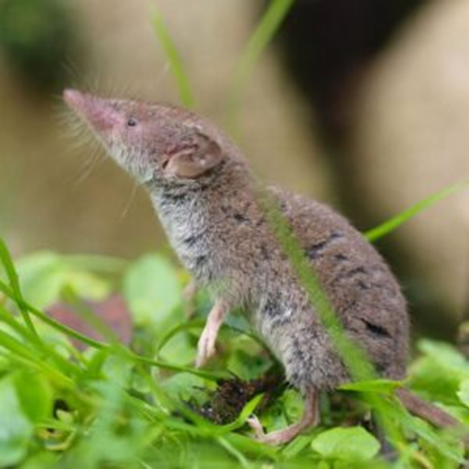 |
Image by Rudmer Zwerver downloaded from the Mammal Society
Below are some upcoming events and talks for you to enjoy around the UK. If you’re eager for even more wildlife events, there are plenty more opportunities for outdoor learning and activities advertised on the Wildlife Trusts event page for the coming months.
Sea otters have the densest fur of all animals, often having upwards of 2.5 million hairs per square inch of skin. That makes sea otter hair around a thousand times more dense than human hair. Otters need such a thick coat as they are the only marine animal that does not have a layer of blubber for insulation. They rely completely on their dense and spiky fur to insulate their body, by trapping a layer of air against the surface of their skin. When grooming their fur, sea otters blow bubbles of air into their coats which are held in place by the barbs on each strand of hair. Interestingly, sea otters can spend up to five hours each day grooming their pelts!
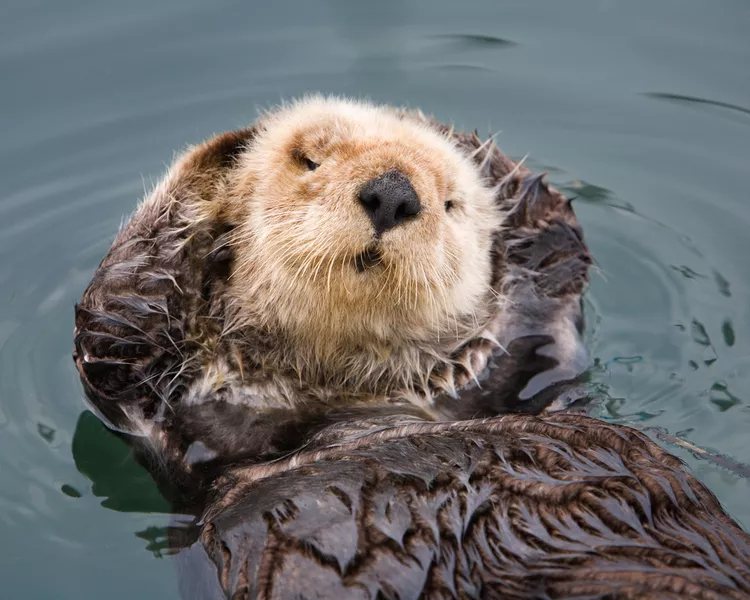
Image by Doug Meek on Shutterstock
Well done to all of you who located and identified the animal as a stoat in last month’s camera trap quiz! Stoats have a distinguishable elongated body, similar to that of a weasel or ferret, with a black tipped tail, orange fur and a distinctive bounding gait. Stoats are native to and widely distributed throughout the UK due to their non-specialist habitat requirements.
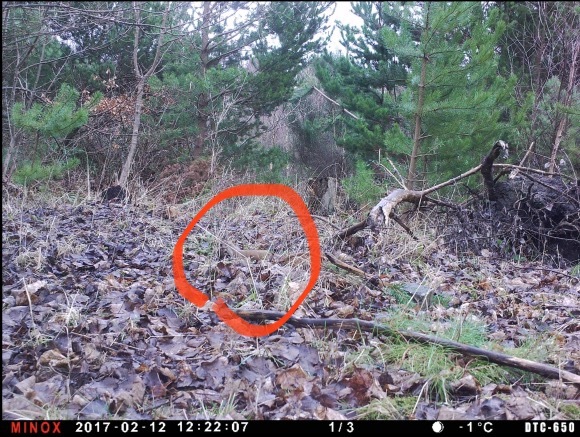
This month we have a wintery camera trap quiz for you. Let us know what species of deer you think is galivanting in the snow in this image and be sure to check the answer in next month’s newsletter!
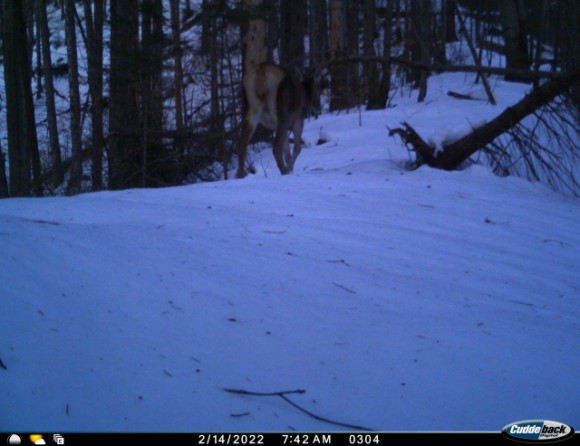
Remember, if you enjoy the camera trap quizzes and want to try some more, we do one weekly on our social media! These are posted across our Twitter, Instagram and Facebook accounts.
Published on November 30th 2022
Welcome to the November issue of the MammalWeb Newsletter! For many of you the first frost is already here, and winter is well on its way to our wild environments. In some ways this may seem like a quiet season for the natural world, but our habitats are as busy and bustling as ever - although perhaps missing some familiar faces for a few months!
It's definitely feeling like the season to hibernate, but the pressures of the festive season are already setting in. In this month's newsletter we talk about hibernation and torpor - the ways that mammals across the British Isles shut down for the winter, and how they prepare. As well as this, we've got links to an article about camera trapping to conserve the Eurasian Otter, a list of exciting upcoming talks and events, and - as always, our Monthly Mammal Fact and Camera Trap Quiz!
We love hearing from you, and if you have anything that you would like us to include in next month’s newsletter, please get in touch at info@PROTECTED
| Sequences uploaded | Sequences classified |
|---|---|
| 4168 | 4710 |
These values include all photos from the general MammalWeb Britain project, and our other public projects.
Congratulations to October's top ten spotters! We very much appreciate everyone's hard work.
| Position | User |
|---|---|
| 1 | Thornandez |
| 2 | Ryce |
| 3 | Moose |
| 4 | cferrari |
| 5 | PetaSams |
| 6 | efarrell |
| 7 | Sprocket46 |
| 8 | kY3 |
| 9 | Luko |
| 10 | Porthbean22 |
Many of you will have met Graham Smith at MammalWeb events in the past. Graham is the lead scientist at the Animal and Plant Health Agency's National Wildlife Management Centre, and has been on the steering group of MammalWeb since its inception. In his day job, Graham is heavily involved in many highly topical issues concerning wildlife, including disease contingency planning and the management of invasive species. We're delighted to note that Graham's decades of work on wildlife management, as well as his work with MammalWeb, have recently been recognised with an Honorary Professorship at Durham University. Congratulations Graham!

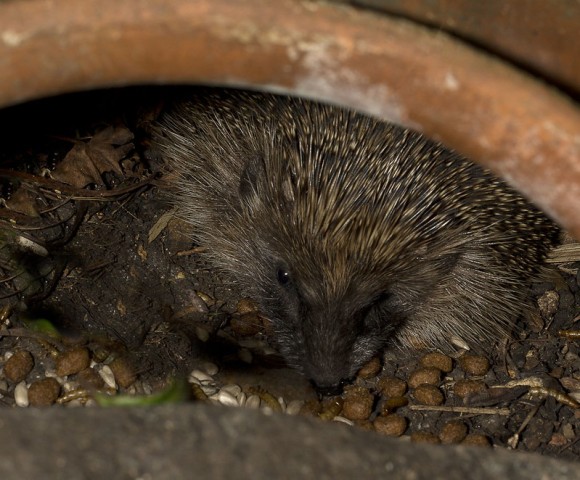
Image via Peter Warne on Flickr
Some of you may be spending this month rushing around to prepare for the swiftly approaching festive season, stockpiling food, gifts and other necessities for staying comfortable and cosy over the holidays. However, we humans aren’t the only ones feeling the pressure of the winter rush. Many of our mammal species here in the British Isles are stockpiling resources of their own before they settle down to sleep through the winter.
Here in the British Isles we have three main mammal groups that go into a true hibernation: bats, hedgehogs and dormice. These mammals slow their metabolism and body temperature right down and go into a state of extreme inactivity. They do this to preserve energy while food is scarce and difficult to access. These mammals need to stockpile these energy sources beforehand, eating in what seems like a state of excess called hyperphagia, and building up essential resources of fat to keep them going through the colder months.
Rather than hibernating, animals like squirrels and badgers pass the winter months in a state called torpor. Torpor is similar to hibernation, and is often referred to as ‘walking hibernation’ because animals that go into torpor over the winter are adapted to waking more frequently with changes in the weather. For squirrels, these periods of wakefulness are used to find and tuck-in to their famous food stores or caches, buried in preparation for the colder months. Badgers, on the other hand, will use this time to hunt; their opportunistic tendencies mean that they will take any food that is readily accessible to them, which frequently includes earthworms, nuts and fruits.
Although hibernating wildlife are more than able to find their own food, there are ways that you can help over the winter. Consider putting un-frozen water out in a bird bath, or leaving piles of logs, leaves and other detritus in the corners of your garden for hedgehogs, toads and invertebrates to settle down in over the winter. If you’re looking for a larger project, you could even build a hibernaculum, specifically designed for amphibians and reptiles to hibernate in. The RSPB have a simple guide here, or there is a slightly more complex one here from the Wiltshire Wildlife Trust.
Sammy, Sian, Russell and Phil recently braved wild weather to head to Edinburgh for the awards ceremony for the Nature of Scotland awards, run by the RSPB and NatureScot. Thanks to everyone who voted for us in the Citizen Science category! Competition was very stiff and, in the end, we lost out to very worthy winners: the UK Butterfly Monitoring Scheme, which has been running since the 1970s and has attracted many tens of thousands of contributors. Frankly, it was an honour to be listed alongside the other projects. We were also beaten to the top spot in the Innovation category, losing out to "Generation Restoration" – an excellent project investigating the best ways to restore Scotland's seagrass meadows. Overall, it was a fun evening – and thoroughly uplifting to hear about all the shortlisted projects, spending an evening focusing on so many positive stories about nature. You can check out all the winning projects here.
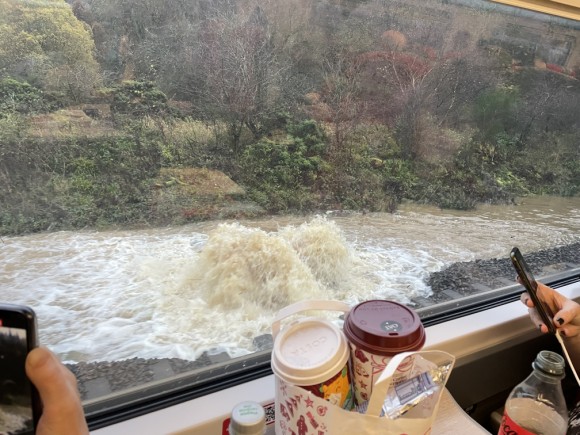
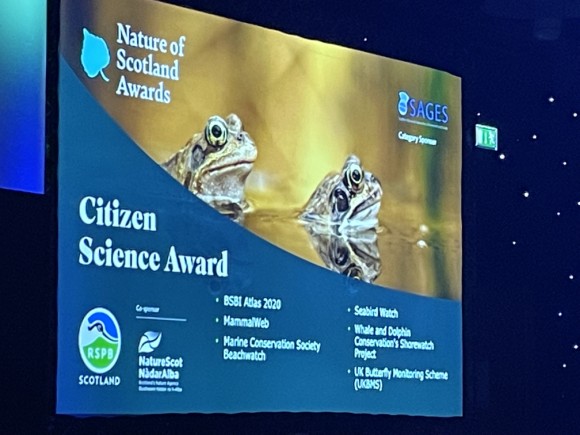
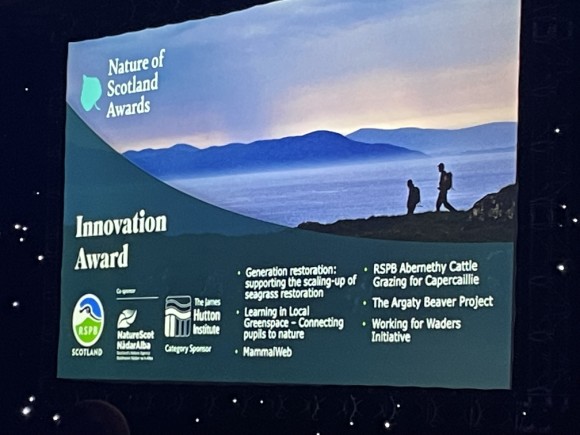
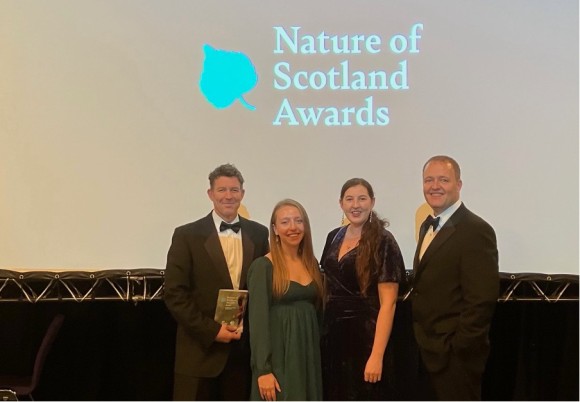
An evidence-based approach to identifying resting sites of Eurasian otter Lutra lutra from camera-trap and field-sign data
A paper by Melanie Findlay and colleagues has recently been published, focusing on camera trapping as a key method for locating otter dens or ‘resting sites’. The Eurasian Otter is the only otter species present in the UK, and is protected by both UK and European law. In theory, this extends to their resting sites; however, this can be difficult to enforce, as these resting sites are hard to identify without a means of gathering evidence. This paper outlines research using examination of both camera trap data and field sign to pin down ways of gathering concrete evidence to help with this identification and further protection of otter resting sites.
Otter resting sites are characterised by the length of stay, with otters staying in these sites for hours rather than minutes. Distinction was also made between ‘spraint’ sites (primarily for scent-marking) and latrine sites (primarily for defecation), a distinction that has not been previously recognised.
The full paper is available to read here through Wiley Online Library.
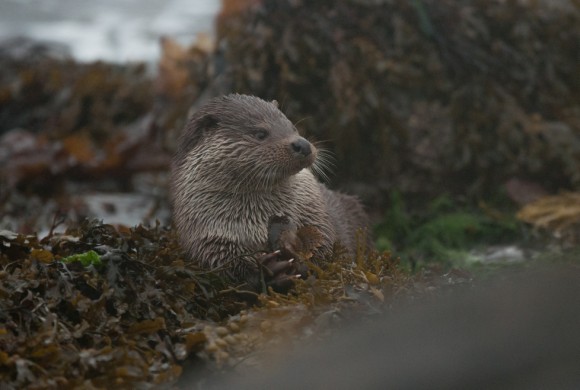
Image by Alana Dewar, Member of IUCN / SSC Otter Specialist Group
Britain is home to three native species of shrew: the common, pygmy and water shrews. Recently, however, the greater white-toothed shrew has been detected in northeast England. In light of this, we would like your help with monitoring shrews.
The greater white-toothed shrew is native to Southern Europe and North Africa; however, it has proven invasive in Ireland, where its successful expansion threatens the native pygmy shrew. The management of invasive species demands their early detection and, as such, we would like to encourage as many people as possible to use camera traps modified for small mammal trapping, baited with mealworms, casters, or similar, so that we can build up a better picture of the occurrence and relative trapping rates of different shrew species in different parts of the country. We might expect records of the potentially invasive shrew to be particularly abundant in the area highlighted on the map below. However, we are interested in shrew records from across the country, in order to have baseline data to help explain any impacts.
We have set up a project for shrew monitoring.If you would like to contribute to this project but don’t know how to get started, please get in touch with us by email.
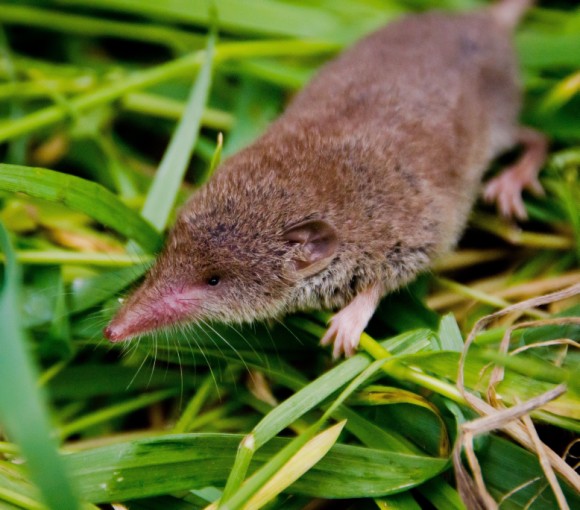
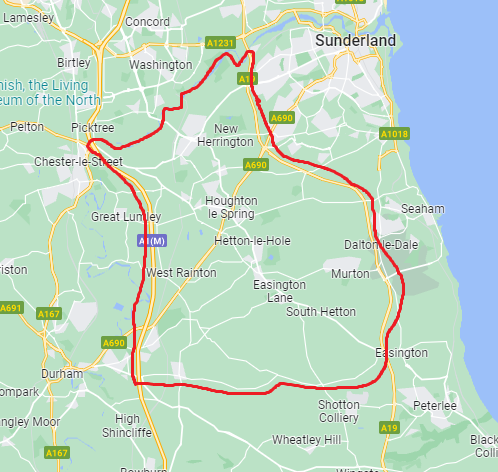
Image GWTS (c) Ruth Carden
We might expect the greater white-toothed shrew to be most likely to be found in the area indicated on the map.
More on Britain's shrews can be found on the Mammal Society's pages.
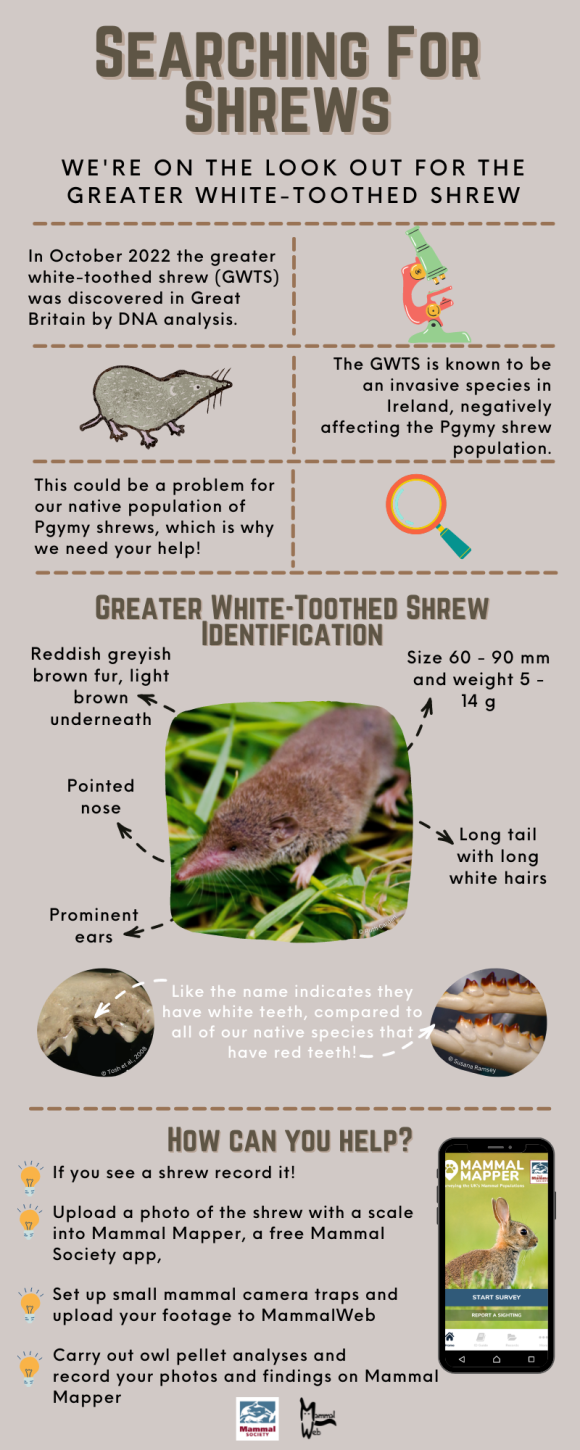
Talks and Events
Below are some events and talks coming up. With a mixture of in-person and online events we hope there is something for everyone to enjoy. For even more opportunities, be sure to look at reserves and sites local to you, there are many opportunities for wreath making and other festive activities in the coming months!
The harvest mouse is the smallest rodent in the British Isles, weighing as little as a 2p coin. On top of this, they are the only mammal in Britain that can actually use its tail as a fifth limb! This prehensile tail is used to cling on to grass stems and other structures in their environment while climbing. Although classed as ‘least concern’ globally by the IUCN red list, they are in decline throughout the UK. Because of this they are on the list of ‘Biodiversity Action Plan’ or BAP classified species, with the intention of reversing this decline. If you are interested in helping harvest mouse conservation, there are training opportunities listed in our ‘talks and events’ section above.
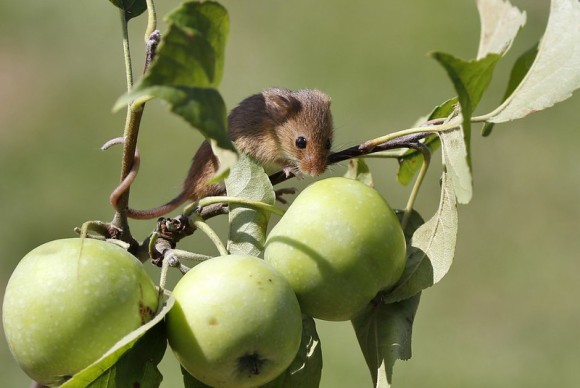
Image via Sonia Johnson on Flickr, note the demonstration of that prehensile tail!
Well done to all of you who identified the pine marten from last month's partial body shot! One of the mustelid species native to the British Isles, the pine marten was once widespread but is now primarily found in Scotland. They have a characteristic white 'bib' marking that is so distinctive it can be used to identify individuals of the species.
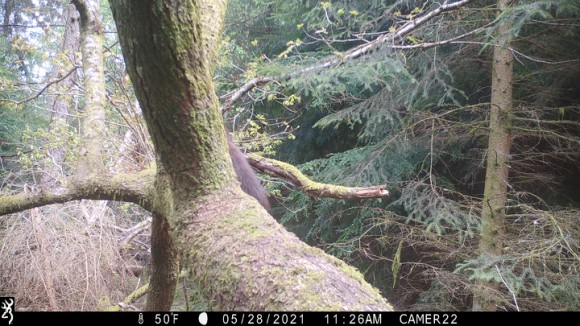
Here’s our image for this month, let us know what and where the animal is, and be sure to check the answer in our next newsletter!
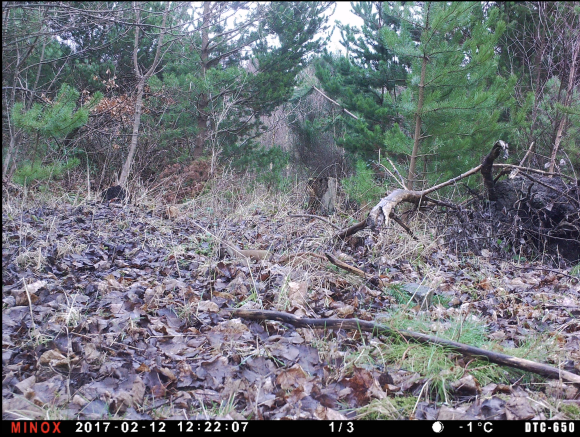
Remember, if you enjoy the camera trap quizzes and want to try some more, we do one weekly on our social media! These are posted across our Twitter, Instagram and Facebook accounts.
Published on October 31st 2022
Welcome to the October issue of the MammalWeb Newsletter! We hope you've been enjoying the spookiest month of the year, and taking the opportunity to look out for wildlife. Many of our mammals will be winding down for the winter, particularly small mammals like squirrels that hibernate during the colder months, but there's still plenty to see! Remember - tracks are easier to spot on frosty ground, so keep your eyes peeled for signs of our furry friends.
Coming up in this month's newsletter we have links to articles from Pen-Yuan Hsing and Sian E. Green. Plus, nature-based news from across the UK, as well as some seasonal folklore, and tips for disposing of this year's pumpkins in a nature-friendly way. As always, we've got our monthly mammal fact, and a new camera trap quiz to test your knowledge!
We love hearing from you, and if you have anything that you would like us to include in next month’s newsletter, please get in touch at info@PROTECTED
| Sequences uploaded | Sequences classified |
|---|---|
| 3433 | 4456 |
These values include all photos from the general MammalWeb Britain project, and our other public projects.
Congratulations to August's top ten spotters! We very much appreciate everyone's hard work.
| Position | User |
|---|---|
| 1 | Deacon |
| 2 | NWKCP |
| 3 | RustyKnight07 |
| 4 | Christian |
| 5 | olivia.wadd |
| 6 | Otter_Spotter |
| 7 | Jotome |
| 8 | TerriM |
| 9 | simone.roverelli |
| 10 | vine cottage |

Camera trapping with photos and videos: implications for ecology and citizen science
We are excited to share a new paper from our very own Sian E. Green and colleagues, "Camera trapping with photos and videos: implications for ecology and citizen science". The paper covers a camera trap survey undertaken in the Forest of Dean, with the intention of comparing the accuracy of IDs submitted for footage that was either still images or videos.
The camera traps were deployed for 4 weeks on a systematic grid throughout the site, with parallel cameras set up to record both video and images of the same subject. The footage from this was uploaded to MammalWeb and classified by our contributors, porentially including you, our reader!
The extent of engagement and accuracy of identifications were compared between the photographic and video datasets.
The result was that citizen scientists more accurately identified the subjects in video footage (95% accuracy for video vs 86% accuracy for photos). Participants were also more likely to offer additional information or ID features, like sex and age, from video footage.
The paper is freely available through the zoological society of London’s Remote Sensing in Ecology and Conservation, and can be read here.
Sian E. Green also wrote a detailed twitter thread outlining the publication, which can be accessed here.

Large-Scale monitoring: the potential of a citizen science camera trapping project in the UK
Pen-Yuan Hsing’s paper Large-scale monitoring: the potential of a citizen science camera trapping project in the UK, which was mentioned in September’s newsletter, is now available to read online through the British Ecological Society.
The article explores the role of large-scale wildlife monitoring projects and emphasises the importance of them in light of the biodiversity loss happening worldwide. MammalWeb is used as an example of an organisation and platform that can be used to implement this large-scale monitoring; this includes an overlview of MammalWeb’s evolution as an organisation.
The article is freely available, and can be read here.
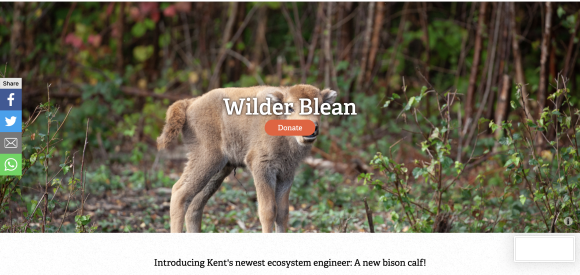
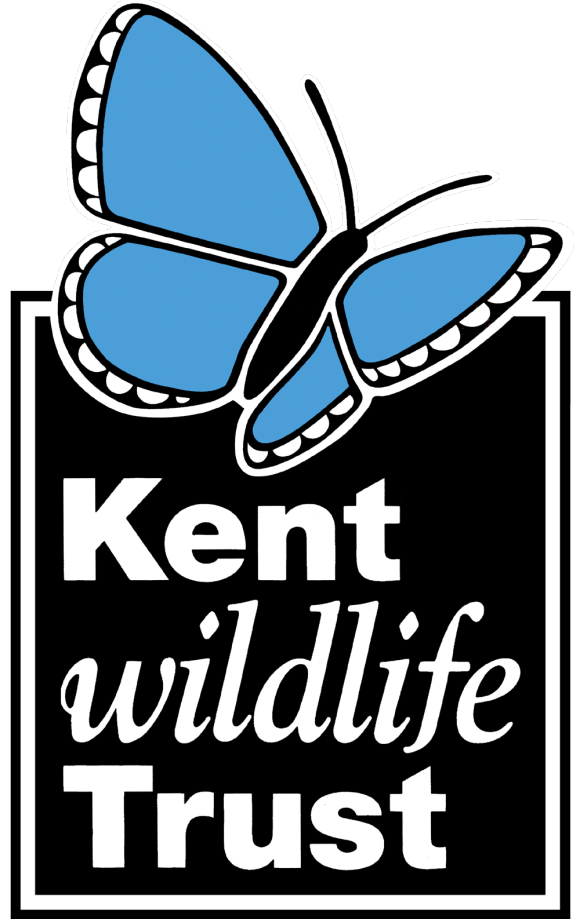
The Wilder Blean project in Kent has had some exciting news in the form of a Bison calf! The project has seen the reintroduction of wild bison as ecosystem engineers to the English forest as part of a wider rewilding project. Three bison were initially released, with the newborn calf arriving this October. This is the first wild bison born in England in thousands of years! The project is hoping to monitor the impact of woodland management by large herbivores, with the addition of Exmoor ponies and wild pigs to come in the future.
Read more about the Wilder Blean project here.
Organisations such as the RSPB and Wildlife Trusts have highlighted concerns around what is percieved as the UK Government’s ‘attack on nature’. This refers to the potential stripping back of- and, in some cases eliminating- legislation that deals with the protection of nature, including the Habitats Regulations. This comes in part from the push away from the EU, and loss of the environmental laws and regulations that stem from the EU as an organisation.
If we look at the impact of EU legislation, the UK was heavily involved in the development of these regulations; consequently, many people - whatever their views on brexit - see this as a retrograde step. Research has demonstrated the positive impacts of EU legislation on wildlife throughout Europe. One example is migrant birds, protected under the Birds Directive. Some species are vulnerable during cross-country migration, and individual site-based nesting protection may not be enough to ensure their safety. Overall, species listed for specific protection under the Birds Directive have fared better than species that are not listed. Morover, the improvement of the fortunes of listed species can be timed to the adoption of the Birds Directive in different areas.With climate change a growing issue, we need to look at protecting our wildlife on a global scale, and using wide-reaching legislation as a safety net for vulnerable species.
Plans to ditch important legislation are compounded by the proposal for ‘investment zones’ - areas of industrial advancement that do not necessarily need to conform to the current sustainable planning systems in place for the protection of nature and habitat.
Since the RSPB’s initial press release, Liz Truss has resigned as prime minister, and so our understanding of where the government will go with their development plans and environmental legislation has become unclear. Unfortunately, however there are no signs for improvement on the proposed legislative rollbacks.
The initial RSPB press release can be read here.
For those of you who wish to read more here is an article on how EU legislation protects bird species, Assessing the Performance of EU Nature Legislation in Protecting Target Bird Species in an Era of Climate Change
Hi I'm Lucy the new MammalWeb social media and communications intern! I am a recent Conservation Biology masters graduate from the University of Sussex and I am passionate about wildlife conservation and working to protect the planet. I'm super excited to be involved in such an interesting project and I'm keeping my eyes peeled in the camera trap footage for my favourite mammal, the otter!

‘Eye of newt and toe of frog, Wool of bat and tongue of dog…’
The quote is, of course, from Shakespeare’s Macbeth, but what are the magical properties of animal parts? There is a theory that animals were historically associated with certain qualities or parts of the body, and that they could be consumed or otherwise used with ritual purposes to heal afflictions of the associated area. For example, folkloric history includes the use of toads to cure ailments of the throat. However, the British Isles and beyond are full of tales of monstrous mammals.
You may have heard of the Selkie, a Scottish folk creature that turns from a seal to a woman, and cannot change back if her skin is stolen, or of Black Shuck, the ghostly apparition of a dog that roams the East Anglian countryside, but here we are taking a dip into the folklore of some common mammals that have a spooky side.
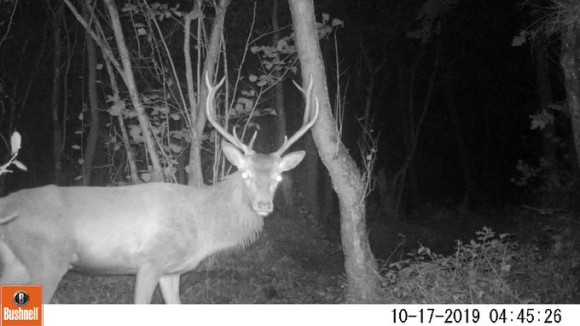
Appearing everywhere from Richard II’s heraldry, to Beowulf, to the oldest pub in Edinburgh, the white hart is a reoccurring emblem in mythology across the isles. With ‘hart’ being another name for stag (coming from the old English ‘heorot’), the white hart is a male deer. Commonly a red deer, but more commonly a fallow buck - particularly as these are more commonly white.
Mythology surrounding white deer is found across the world. A White Stag in Celtic mythology is a creature of the Otherworld, and symbolises that the border between worlds is thin or that ‘otherworldly’ things are afoot. In folklore from the British Isles the white stag is often conflated with horned gods such as Herne the hunter or Cernunnos, and even with other mythological symbols like the unicorn.
The thing that ties all tales of the white stag together is that it cannot be caught; in some instances it leads people between worlds, or represents fate; in others, the catching or trammelling of this mythical beast can have dire consequences. JRR Tolkien plays with this theme in the Hobbit, where travellers through a menacing forest come across a white hart and attempt to shoot it, an action that has immediate and disastrous effects.
While the black cat of folklore is certainly Felis catus, the domestic cat, there are plenty of black cats in the wilderness to fit in with our theme! (Even if we do have to go slightly farther afield than the British Isles to see them).
As it stands, we know of 13 species of wild cat that exhibit melanism, with the most famous being jaguars and leopards - the melanistic colourations of which are more popularly known as ‘black panthers’.
But what is melanism? In short, it’s a genetically-driven trait that manifests as an increase in the ‘melanin’ pigment that is significantly higher than the norm. This can be seen throughout the animal kingdom, and more common examples to us in the British Isles may include fallow deer, grey squirrel and fox.
Melanism in cats is generally more common in moist forested areas, which is perhaps why the black panther remains as the famous choice. However, in recent years there has been internet buzz about sightings of rare melanistic Canada Lynx.
In any case, contrary to what the stories might say, it is most definitely lucky to have a black wild cat cross your path!
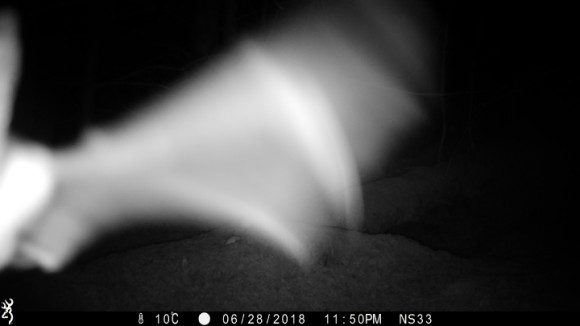
Bats are often toted as a symbol for Halloween and the macabre, but where does this connection come from? Bram Stoker is often given credit for this due to his novel Dracula, with the titular vampire transforming into a bat to flee from the window of one of his thralls. There is also the connection to ‘vampire bats’ - bats who exhibit hematophagy, or drink blood. Blood-drinking bats are often the most commonly discussed in popular culture, but there are only three species out of over 1,000 that actually fall into this category. These three are the common vampire bat, the white winged vampire bat, and the hairy-legged vampire bat, all of which are only found in the Americas.
On a simpler note, the nocturnal nature of bats lends itself to associations with all things spooky and, as the autumn nights close in and the sun sets earlier it is much more common to see them flitting around in the dusk. It has been suggested that as earlier cultures held bonfires to celebrate Samhain (modern Halloween’s Celtic inspiration) insects would be attracted to the light, and bats would be attracted to the insects, and so an association was born. Another theory surrounds the fact that October falls within the season where bats can be seen swarming around hibernation sites.
These are just a small snippet of the spooky animals that haunt the season, for those looking to read further theres an article here from the Scottish Wildlife Trusts about Bats and Halloween, and a fantastic resource for book recommendations on myths and folklore here from the organisers of the popular social media event #folklorethursday
It’s the time of year again when many of us will be carving pumpkins to decorate our homes and delight trick or treaters (or scare them off in some cases!), but it’s worth thinking about what to do with your pumpkin once the event is over. There are tips and tricks floating around the internet, suggesting leaving them out for wildlife; however, this is definitely not recommended. Pumpkins aren’t a native species here, and while some animals may enjoy having a nibble they could make others severely unwell. As with orange skins and banana peel, there are some fruits and vegetables that are best left to the compost bin.
An article here from Forestry England presents some creative solutions for leftover pumpkins, including creating pumpkin face masks and donating leftover pumpkins to zoos for enrichment.
To celebrate the news at Wilder Blean, we’re focusing this month’s mammal fact on European bison! Bison are easily identified by their distinct silhouette, particularly their shoulder hump. They are the heaviest native land mammal in Europe, with the potential for males to weigh up to a whopping 1000kg.
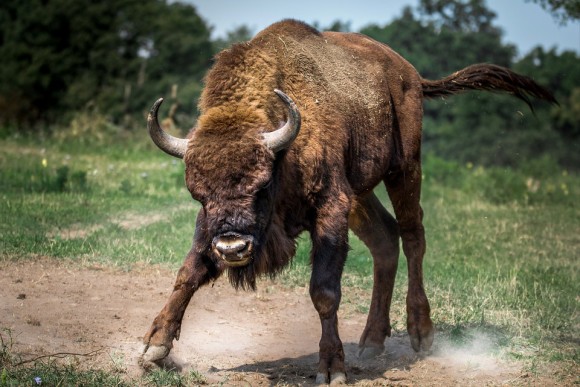
Well done to everyone who identified the Jay in last month's quiz! The jay is the UK's most colourful corvid, sporting spots of bright blue wing feather.
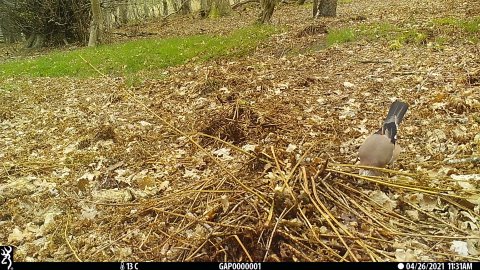
This month we've got a tricky one for you - try and identify this animal based on the partial body shot!
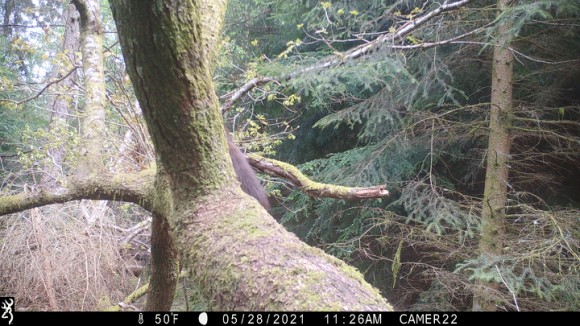
Remember, if you enjoy the camera trap quizzes and want to try some more, we do one weekly on our social media! These are posted across our Twitter, Instagram and Facebook accounts.